Facebook
Twitter
WhatsApp
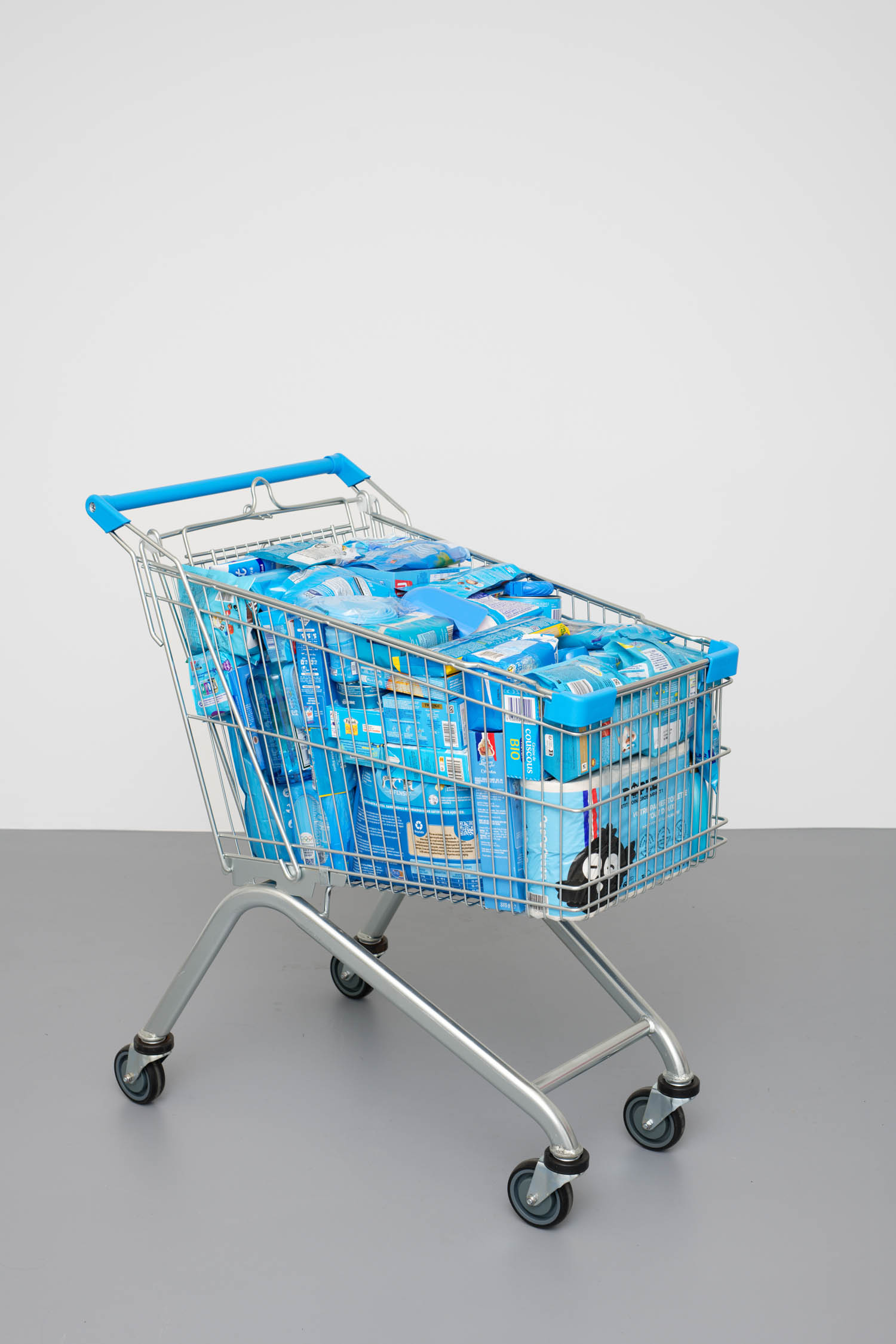
Adriana Martínez Barón
CMYK
2017–ongoing
Four metal shopping carts, spray paint, spray primer, glossy varnish, groceries and household supplies from local supermarkets
104 × 64 × 81 cm each

Adriana Martínez Barón
CMYK
2017–ongoing
Four metal shopping carts, spray paint, spray primer, glossy varnish, groceries and household supplies from local supermarkets
104 × 64 × 81 cm each
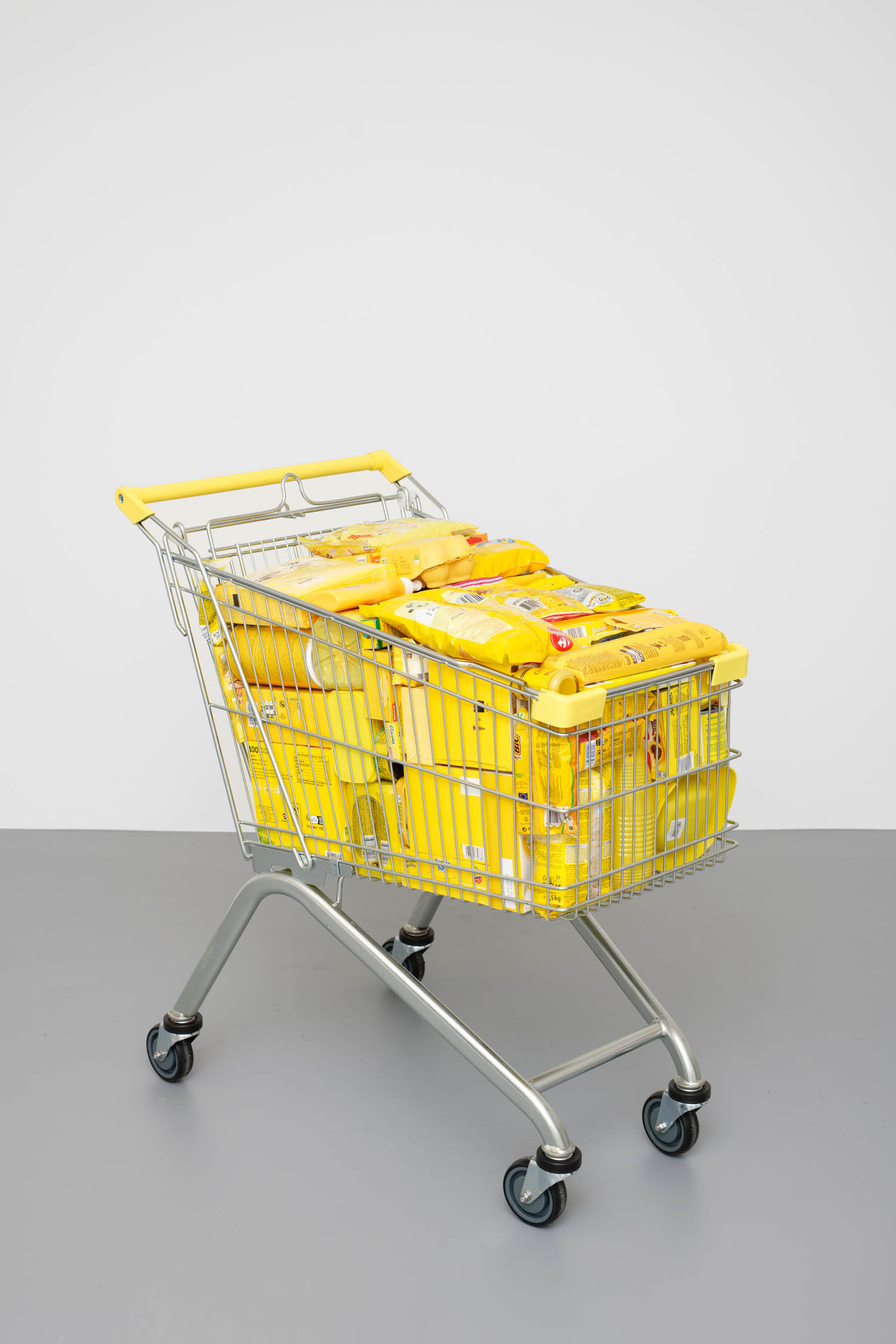
Adriana Martínez Barón
CMYK
2017–ongoing
Four metal shopping carts, spray paint, spray primer, glossy varnish, groceries and household supplies from local supermarkets
104 × 64 × 81 cm each
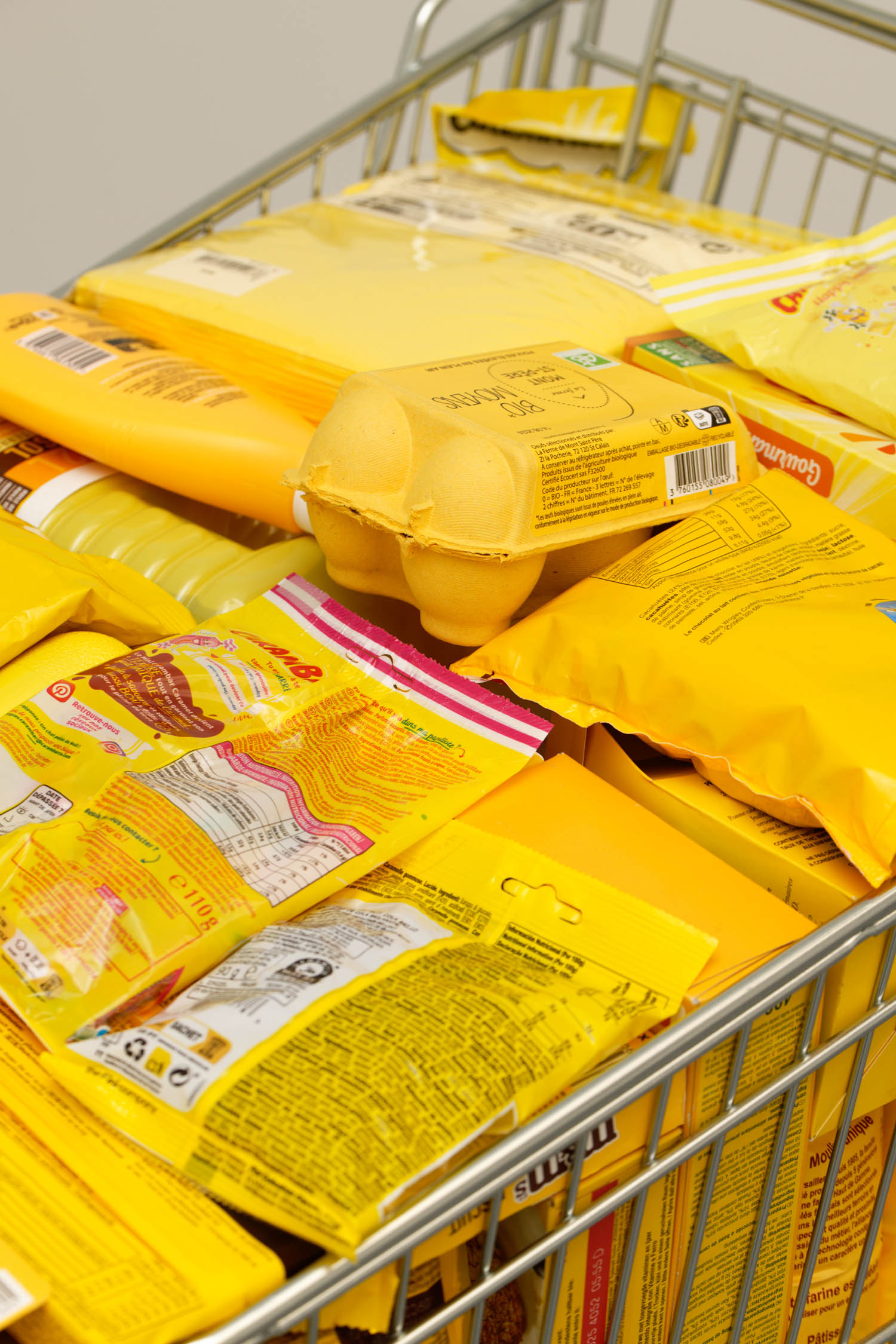
Adriana Martínez Barón
CMYK
2017–ongoing
Four metal shopping carts, spray paint, spray primer, glossy varnish, groceries and household supplies from local supermarkets
104 × 64 × 81 cm each
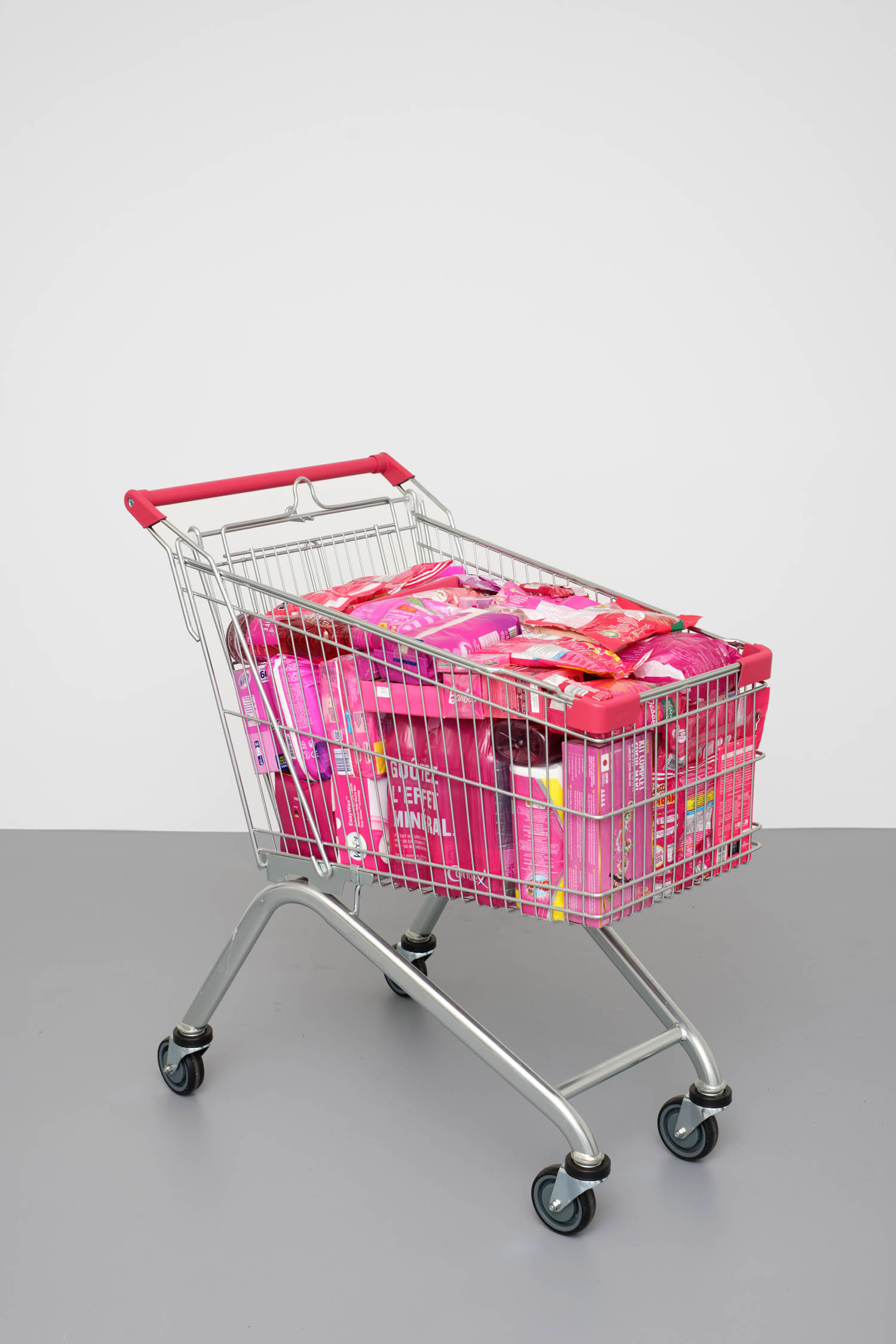
Adriana Martínez Barón
CMYK
2017–ongoing
Four metal shopping carts, spray paint, spray primer, glossy varnish, groceries and household supplies from local supermarkets
104 × 64 × 81 cm each

Adriana Martínez Barón
CMYK
2017–ongoing
Four metal shopping carts, spray paint, spray primer, glossy varnish, groceries and household supplies from local supermarkets
104 × 64 × 81 cm each
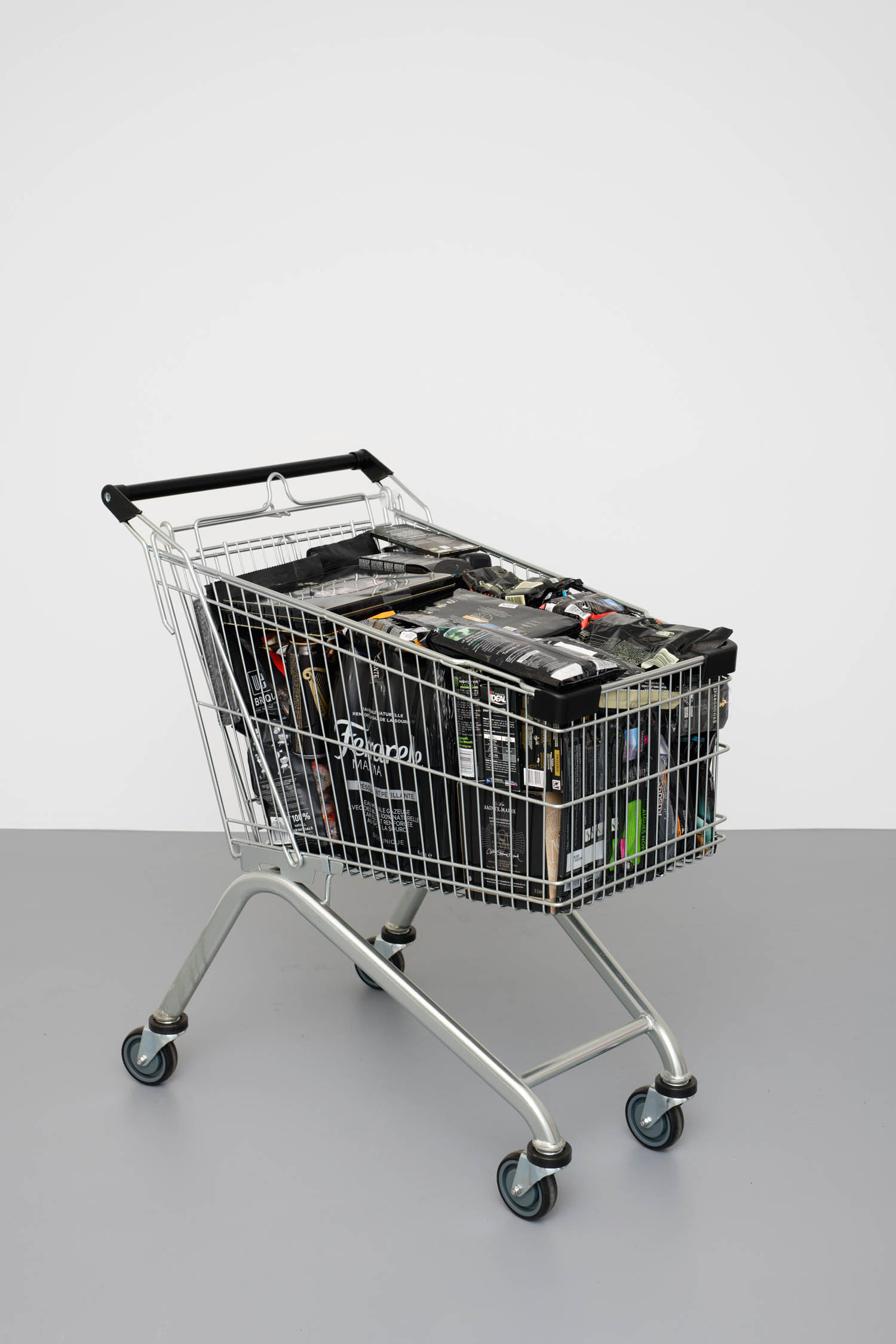
Adriana Martínez Barón
CMYK
2017–ongoing
Four metal shopping carts, spray paint, spray primer, glossy varnish, groceries and household supplies from local supermarkets
104 × 64 × 81 cm each
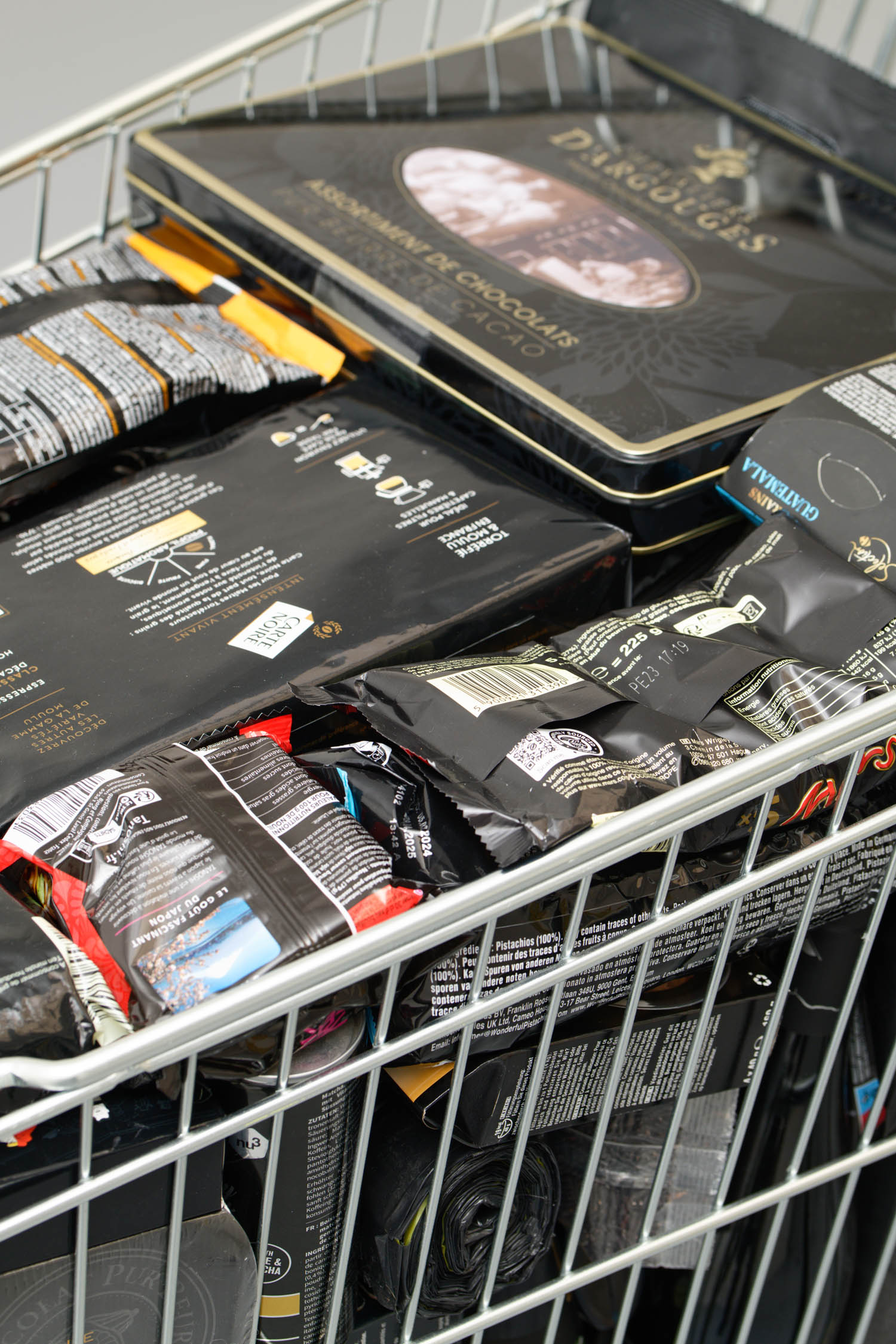
Adriana Martínez Barón
CMYK
2017–ongoing
Four metal shopping carts, spray paint, spray primer, glossy varnish, groceries and household supplies from local supermarkets
104 × 64 × 81 cm each
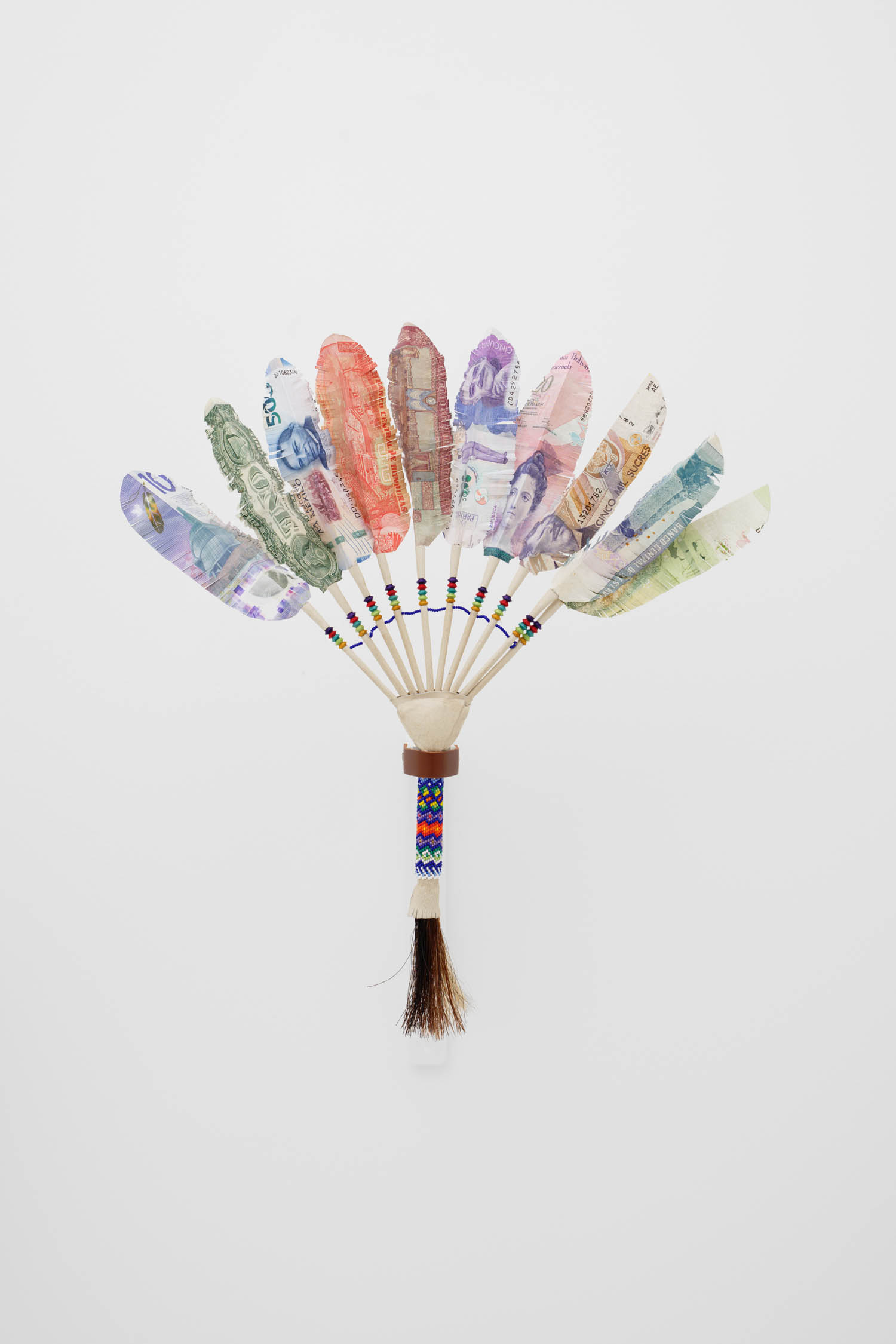
Adriana Martínez Barón
Peyote Fan
2023
Banknotes, wood, leather, beads, horsehair
47 × 27 cm

Adriana Martínez Barón
Prophecy
2023
Banknotes
114.3 × 58.4 × 63.5 cm
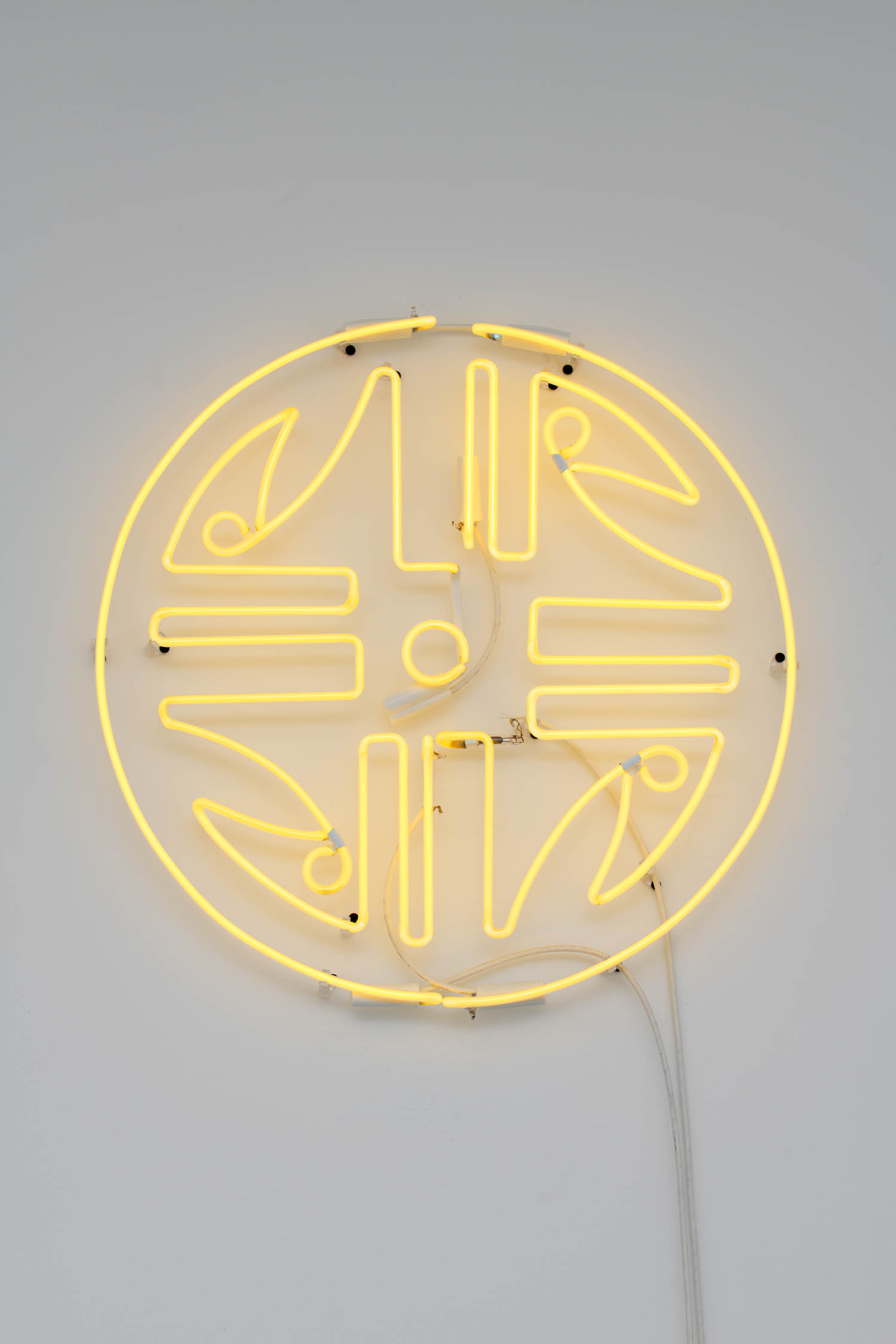
Adriana Martínez Barón
Doscientos pesos oro
2024
Neon
57 × 57 cm
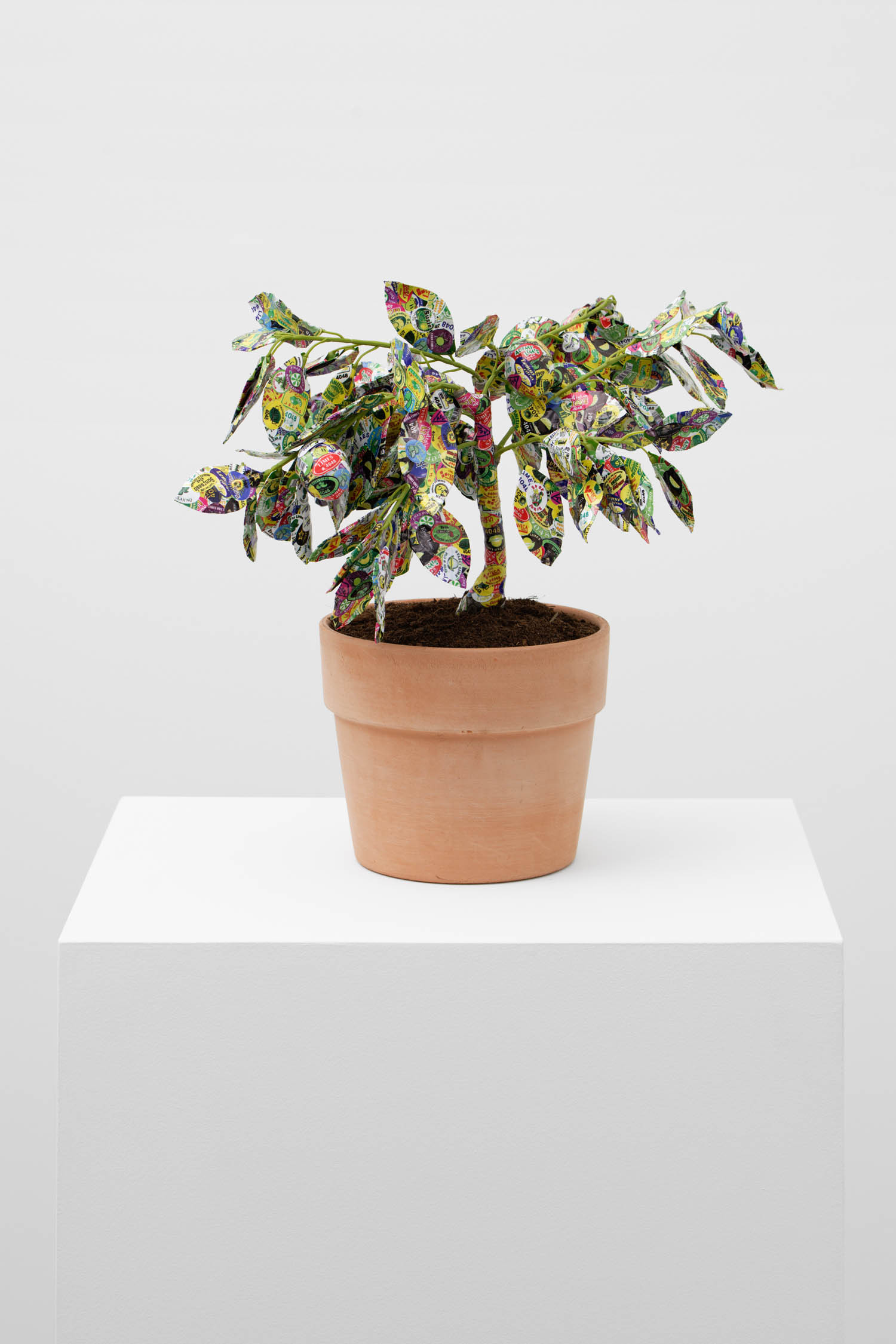
Adriana Martínez Barón
40-48 (Lemon Tree)
2023
Stickers on faux plant
56 × 50 × 50 cm
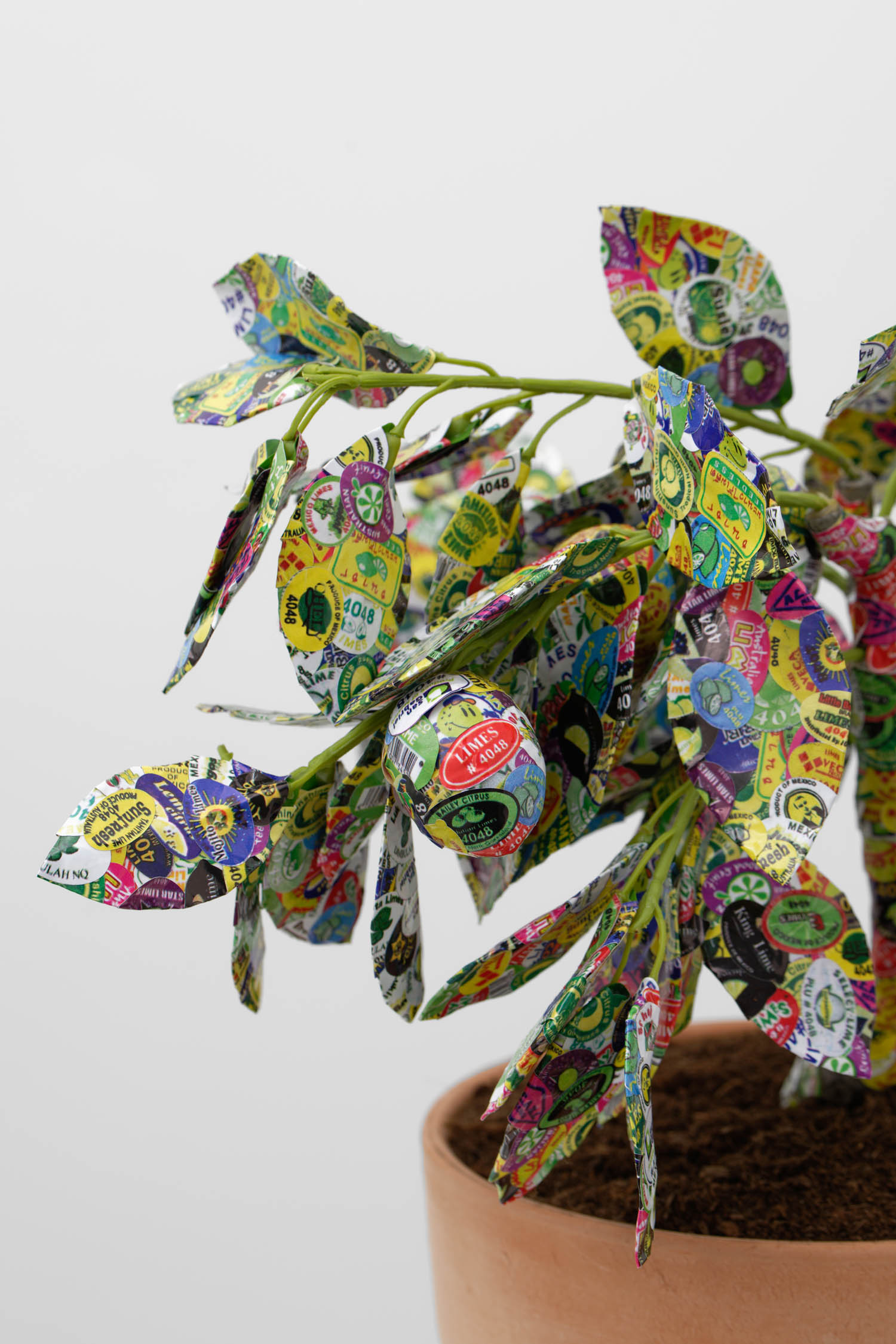
Adriana Martínez Barón
40-48 (Lemon Tree)
2023
Stickers on faux plant
56 × 50 × 50 cm

Adriana Martínez Barón
At the End of the Rainbow
2023
Banknotes and rubber band
7 × 7 × 7 cm
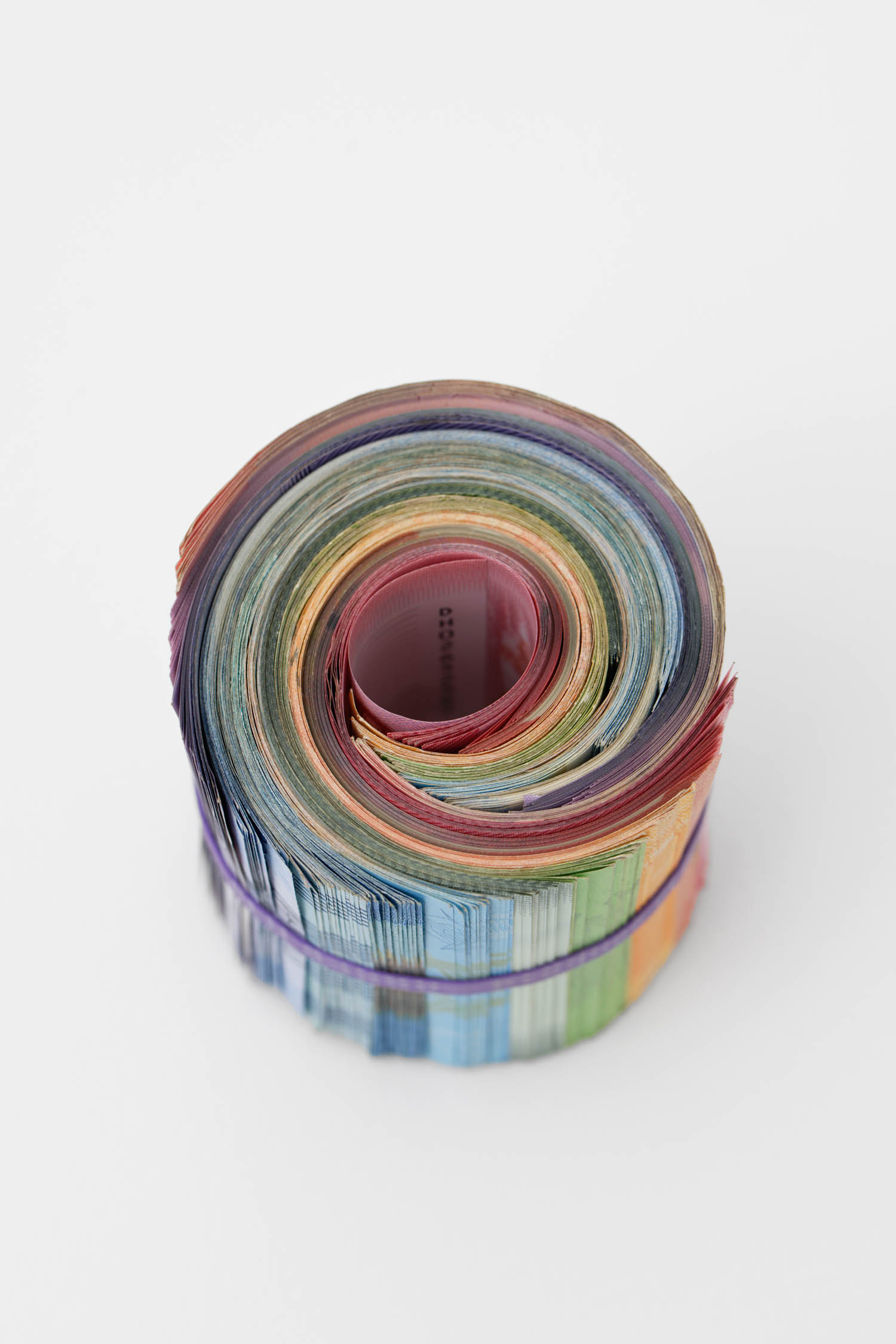
Adriana Martínez Barón
At the End of the Rainbow
2023
Banknotes and rubber band
7 × 7 × 7 cm

Adriana Martínez Barón
Denegada (Denied)
2023
Acrylic paint, vintage map
59 × 25 cm (unframed)
64 × 30 cm (framed)
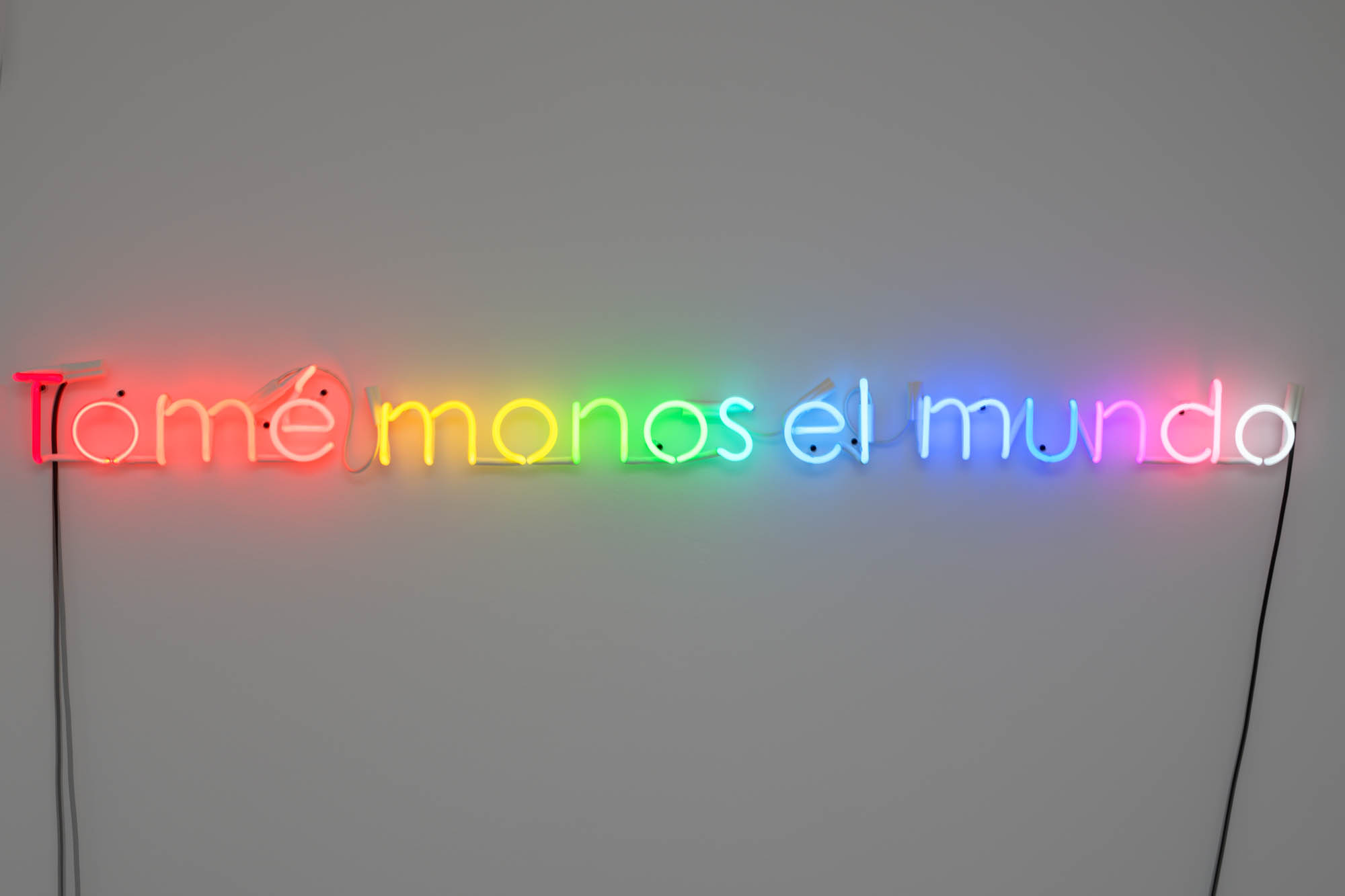
Adriana Martínez Barón
Tomémonos El Mundo
2024
Neon
11× 167 cm
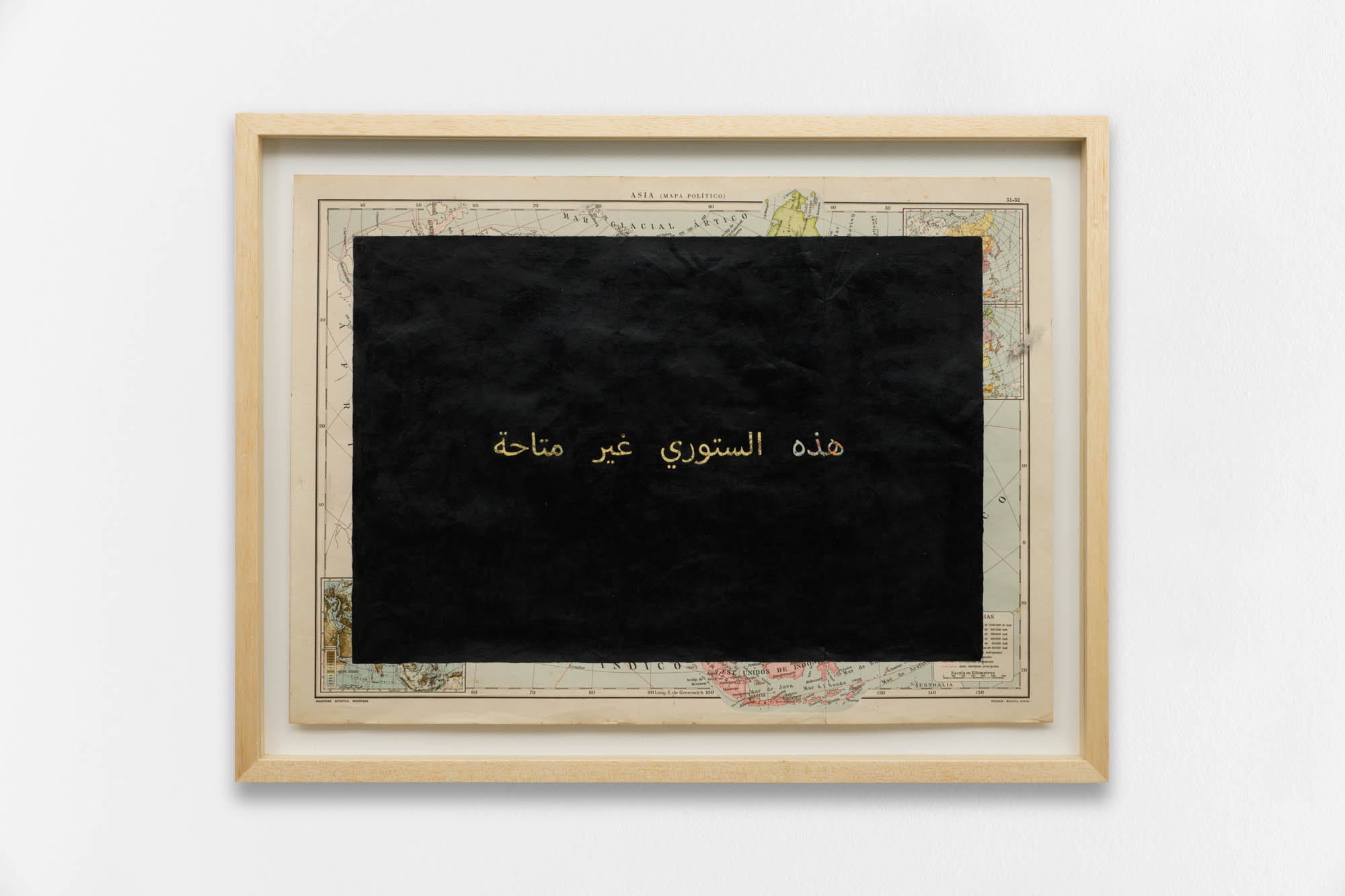
Adriana Martínez Barón
Time Flies (detail)
2023
Acrylic paint, vintage maps
Asia, Europe, and America
36 × 50 cm (unframed)
44 × 58 cm (framed)
Oceania and Africa
26 × 37 cm (unframed)
33 × 44 cm (framed)
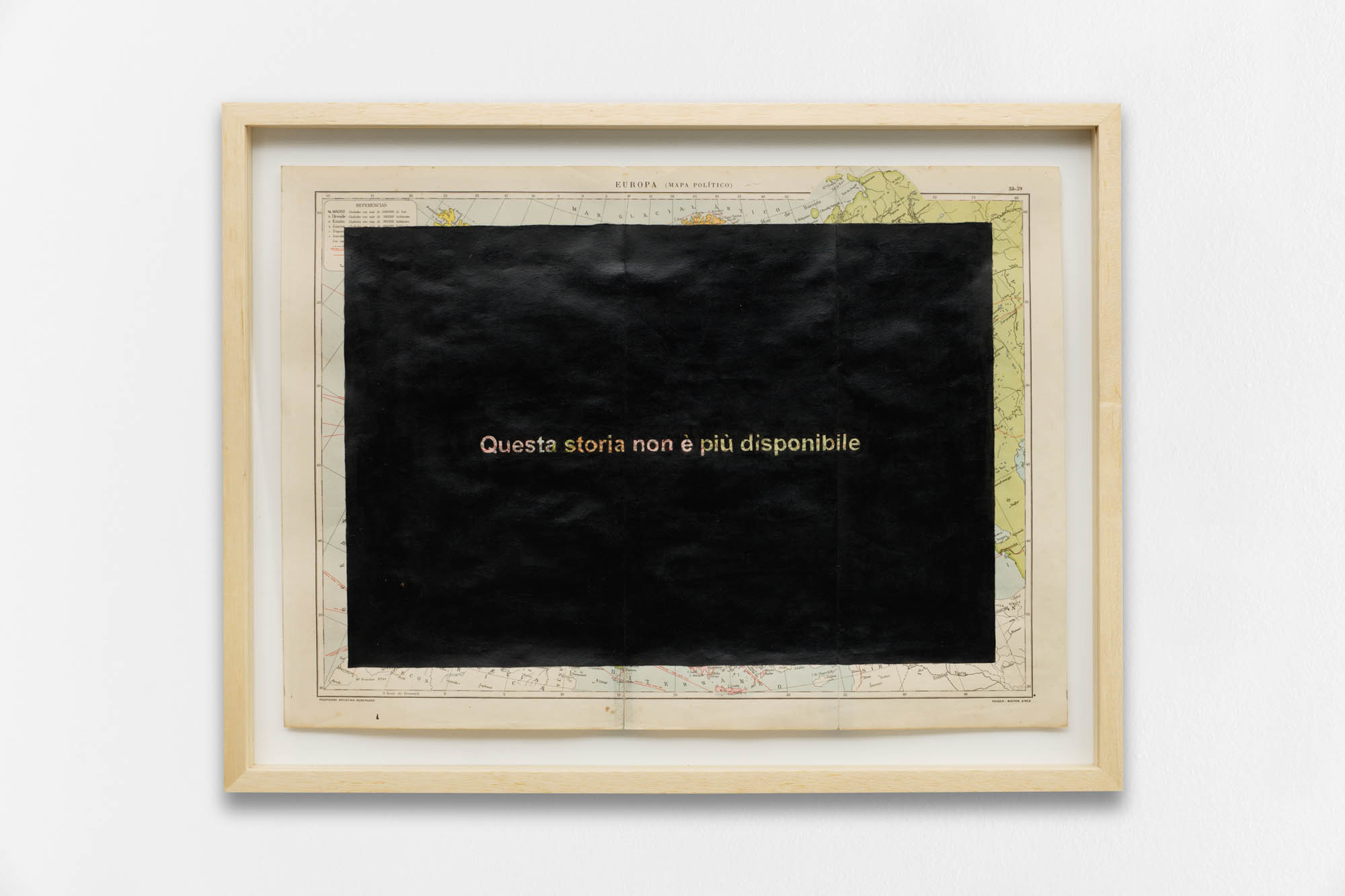
Adriana Martínez Barón
Time Flies (detail)
2023
Acrylic paint, vintage maps
Asia, Europe, and America
36 × 50 cm (unframed)
44 × 58 cm (framed)
Oceania and Africa
26 × 37 cm (unframed)
33 × 44 cm (framed)
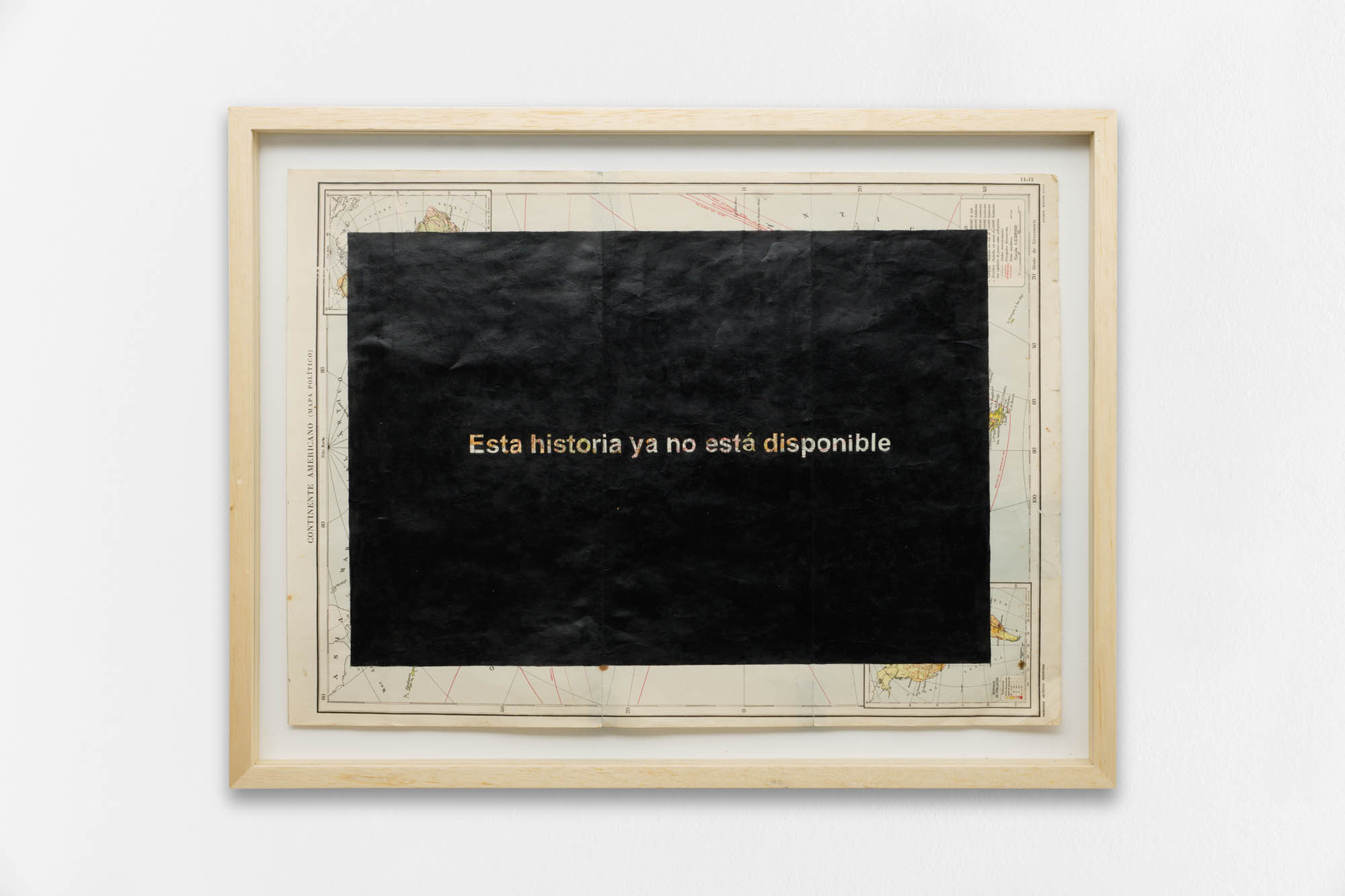
Adriana Martínez Barón
Time Flies (detail)
2023
Acrylic paint, vintage maps
Asia, Europe, and America
36 × 50 cm (unframed)
44 × 58 cm (framed)
Oceania and Africa
26 × 37 cm (unframed)
33 × 44 cm (framed)
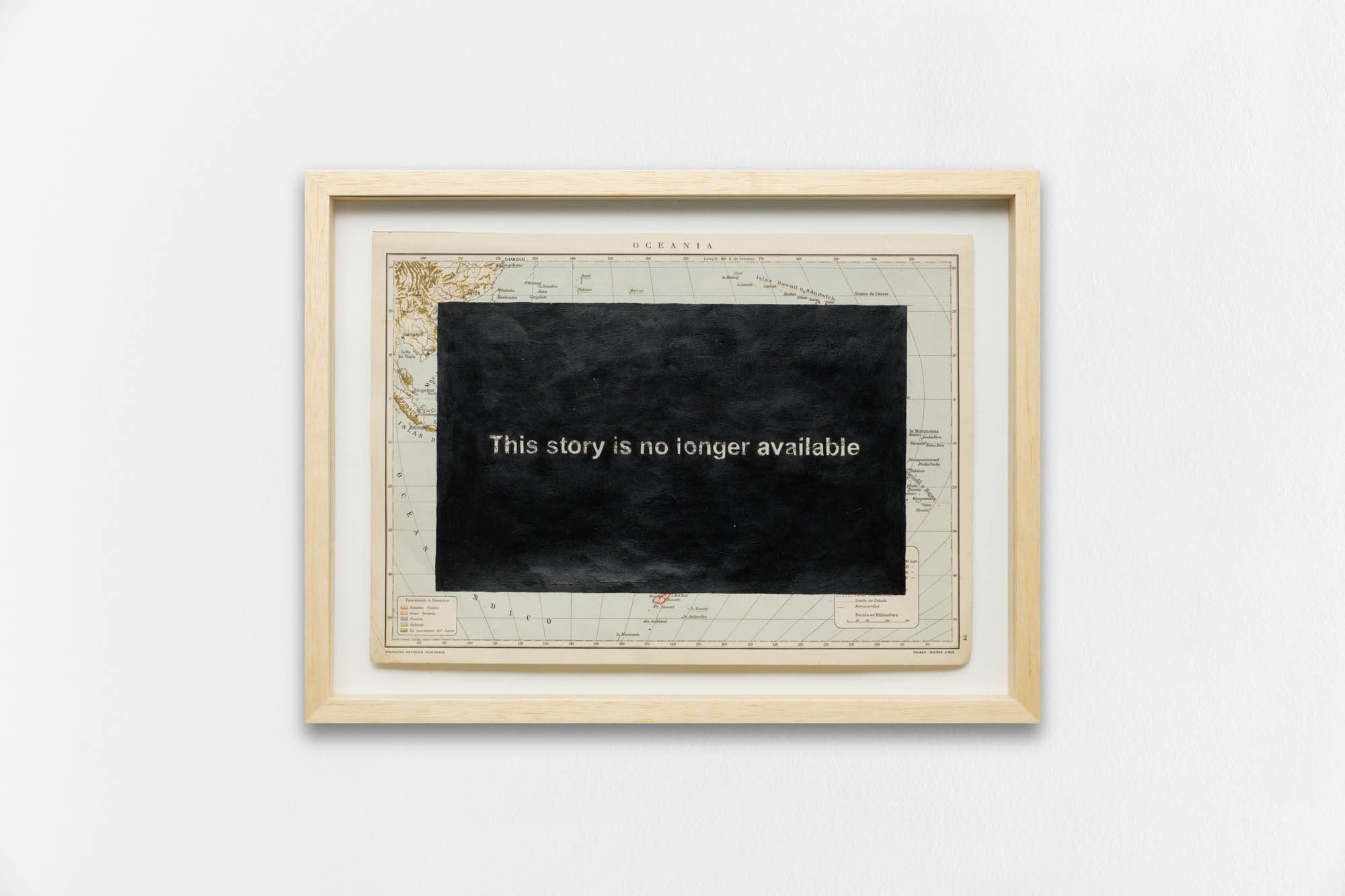
Adriana Martínez Barón
Time Flies (detail)
2023
Acrylic paint, vintage maps
Asia, Europe, and America
36 × 50 cm (unframed)
44 × 58 cm (framed)
Oceania and Africa
26 × 37 cm (unframed)
33 × 44 cm (framed)
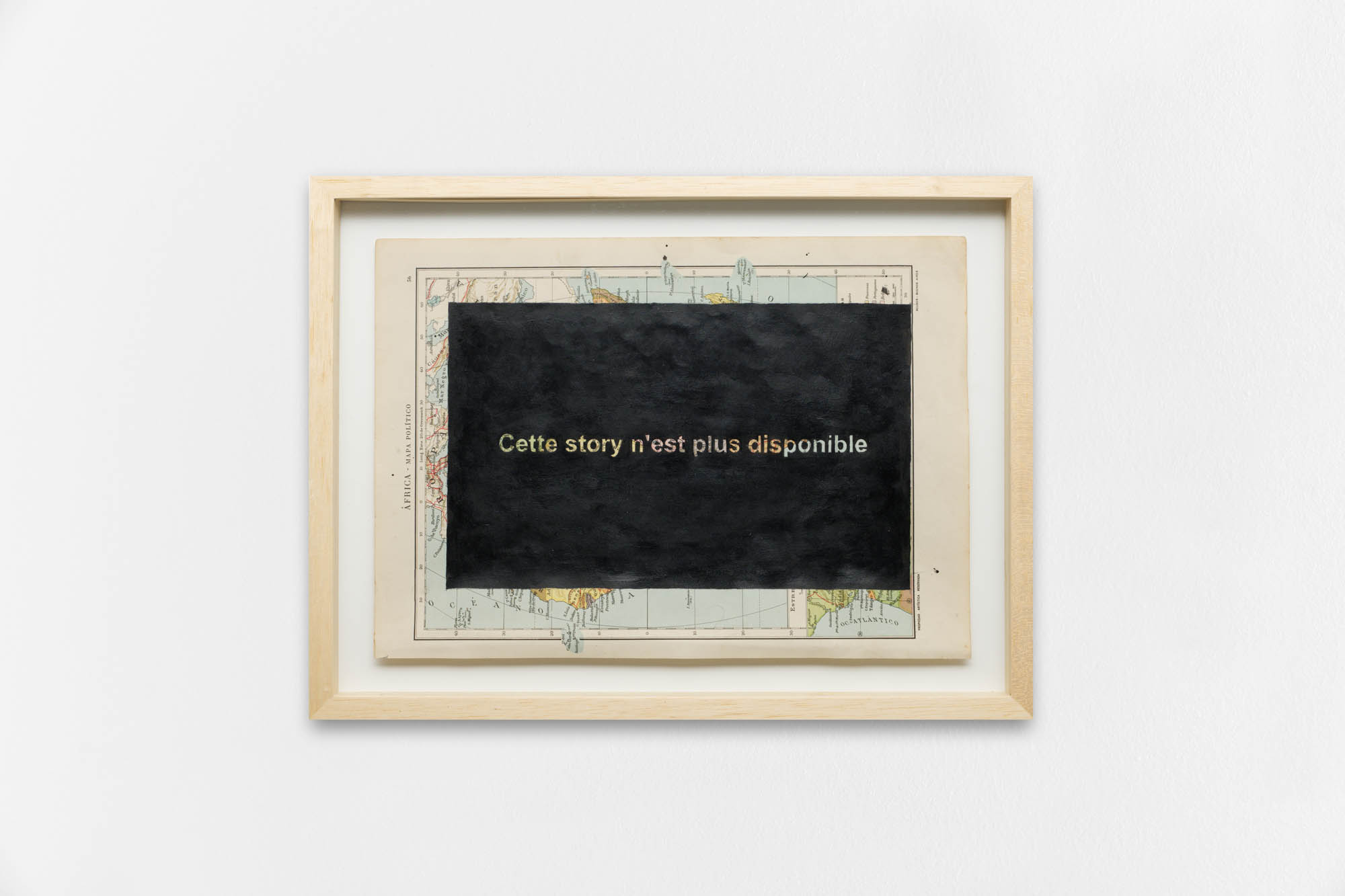
Adriana Martínez Barón
Time Flies (detail)
2023
Acrylic paint, vintage maps
Asia, Europe, and America
36 × 50 cm (unframed)
44 × 58 cm (framed)
Oceania and Africa
26 × 37 cm (unframed)
33 × 44 cm (framed)
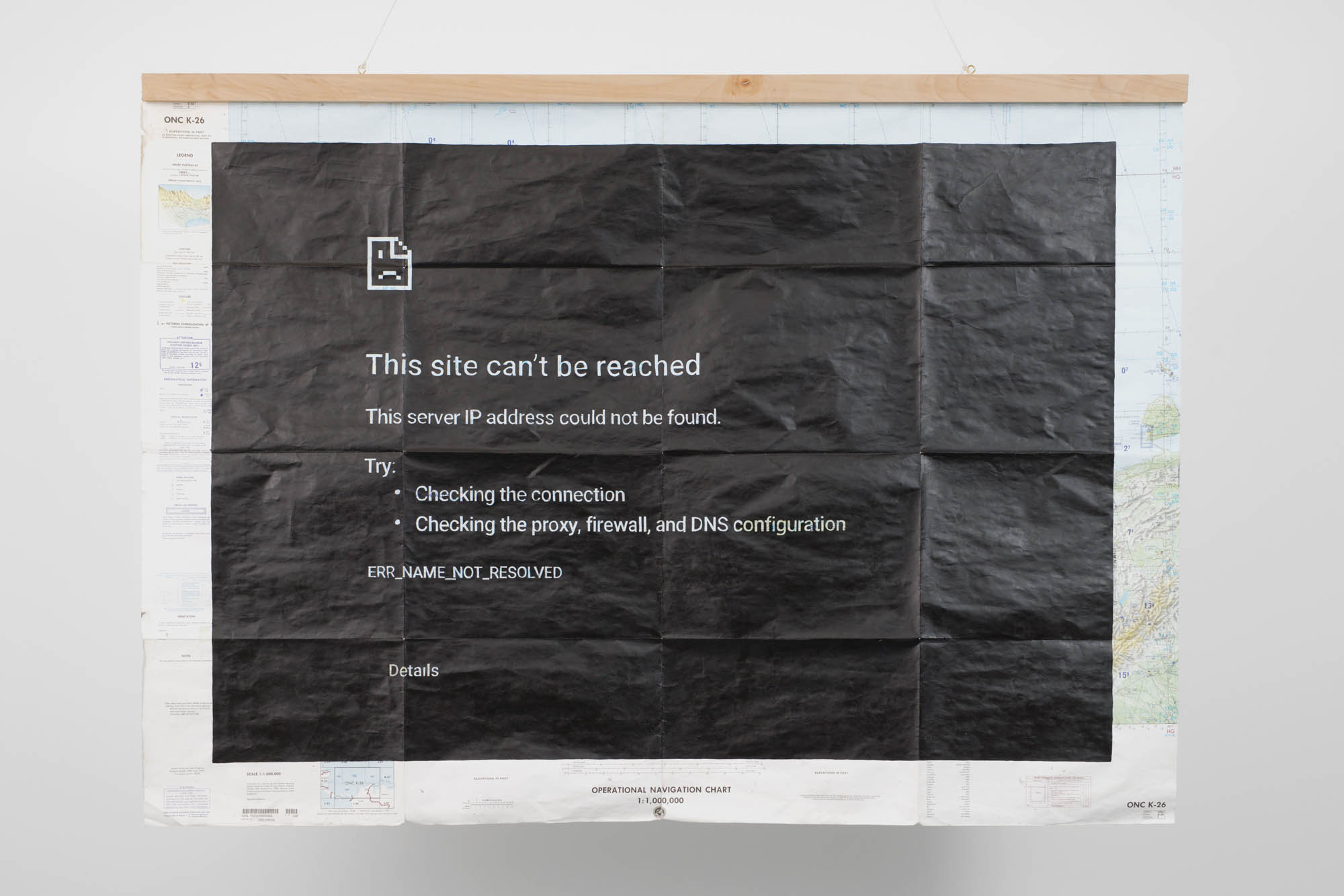
Adriana Martínez Barón
This Site Can’t Be Reached
2023
Acrylic paint on vintage map
145 × 104 cm
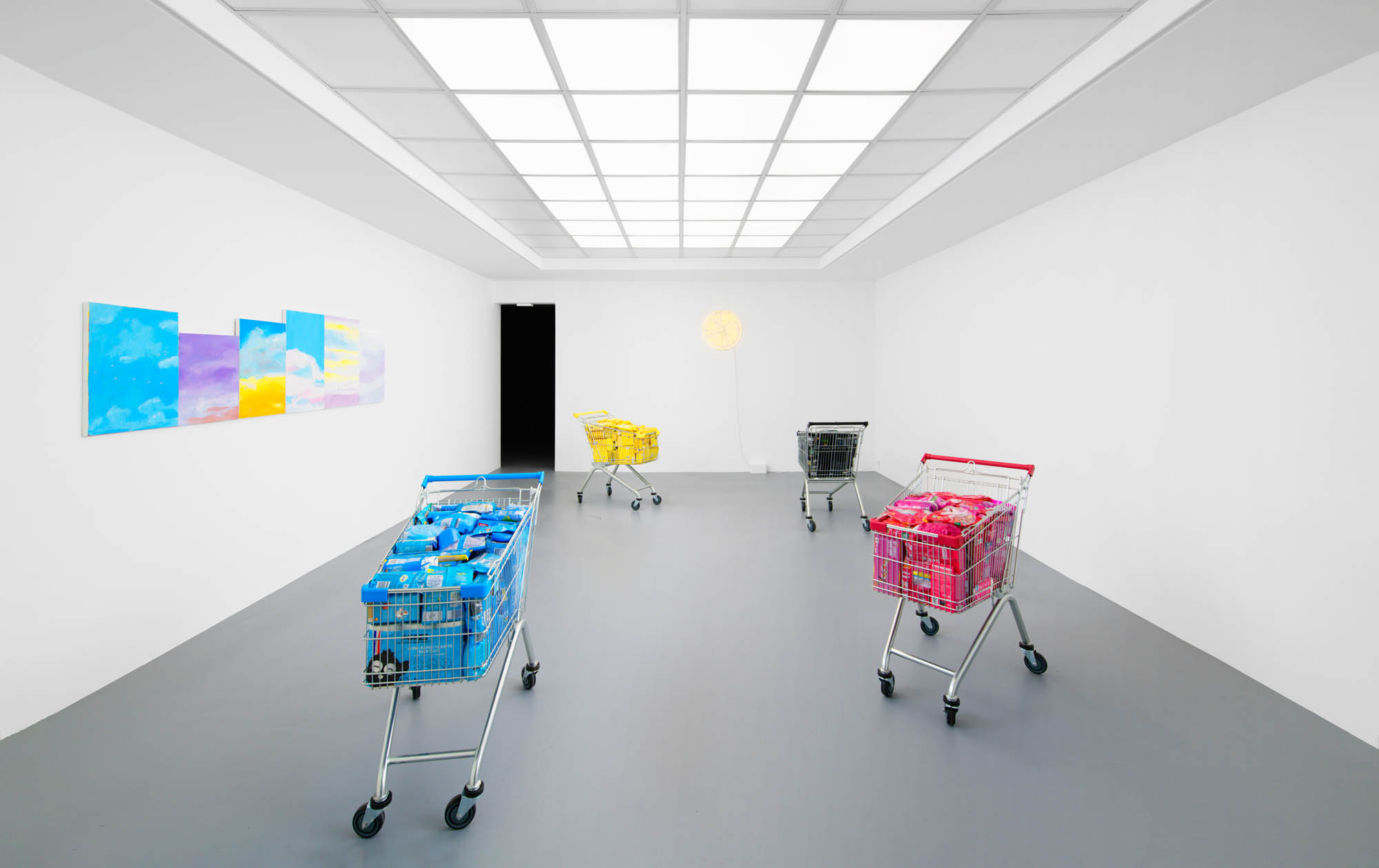
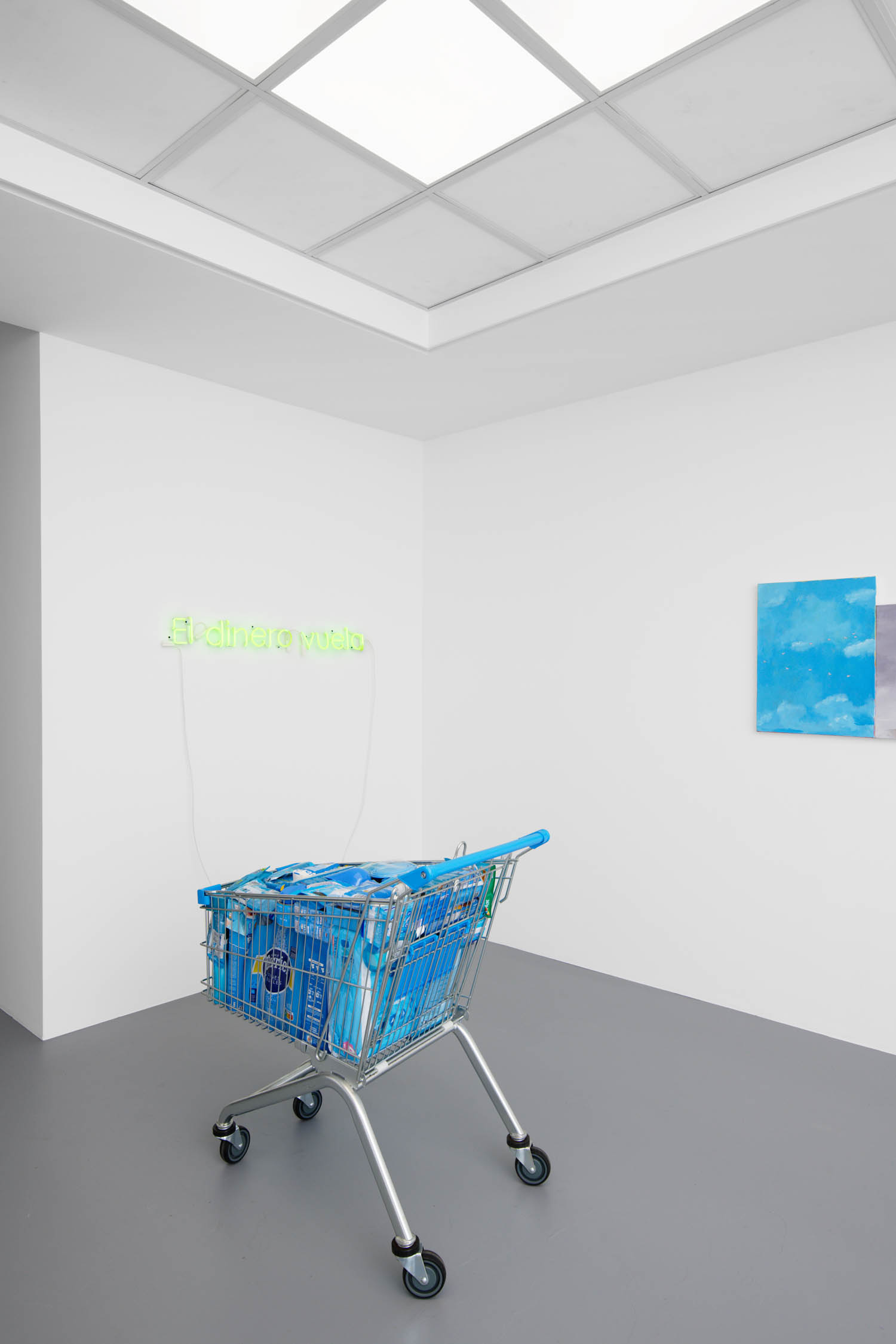
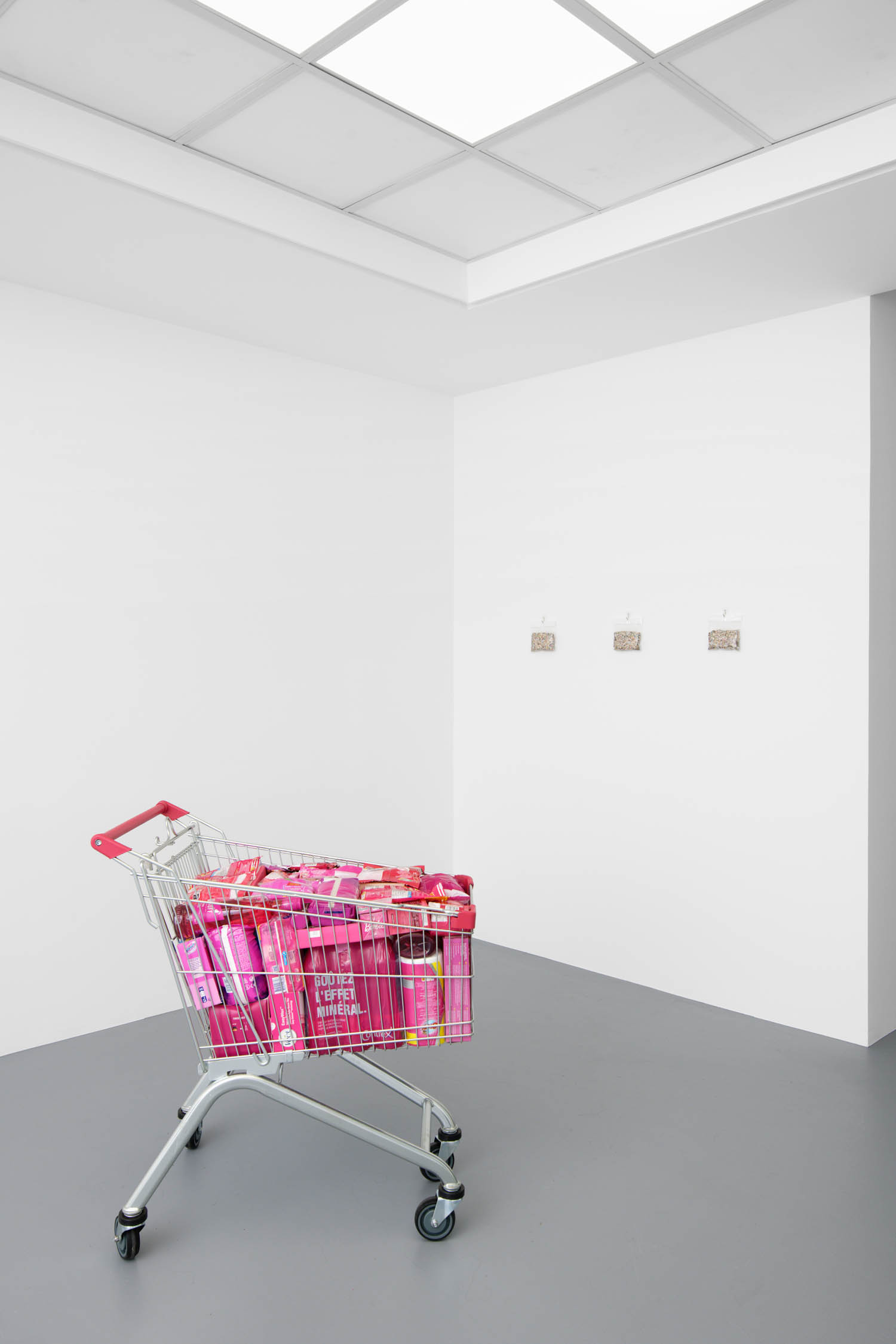
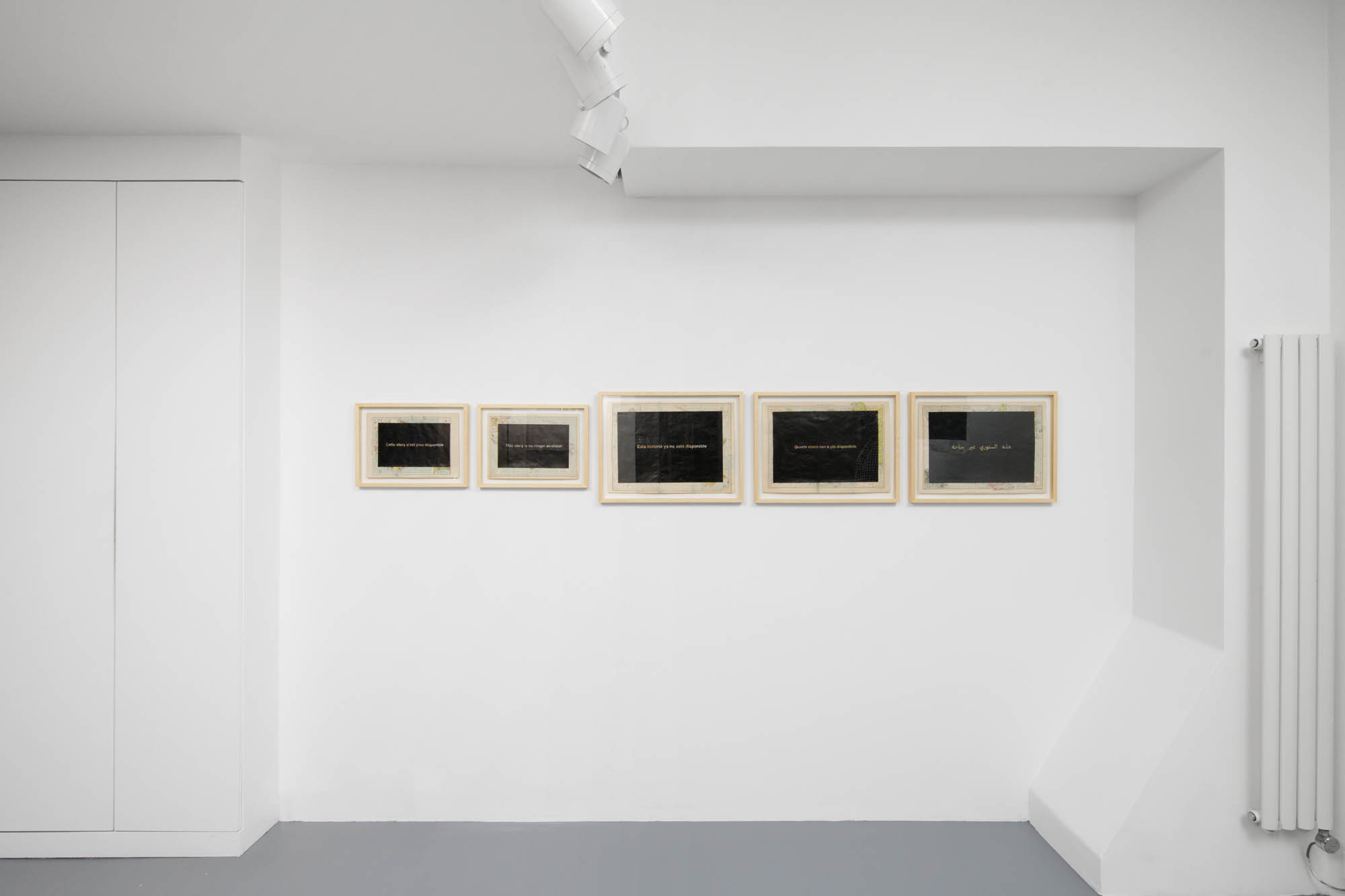
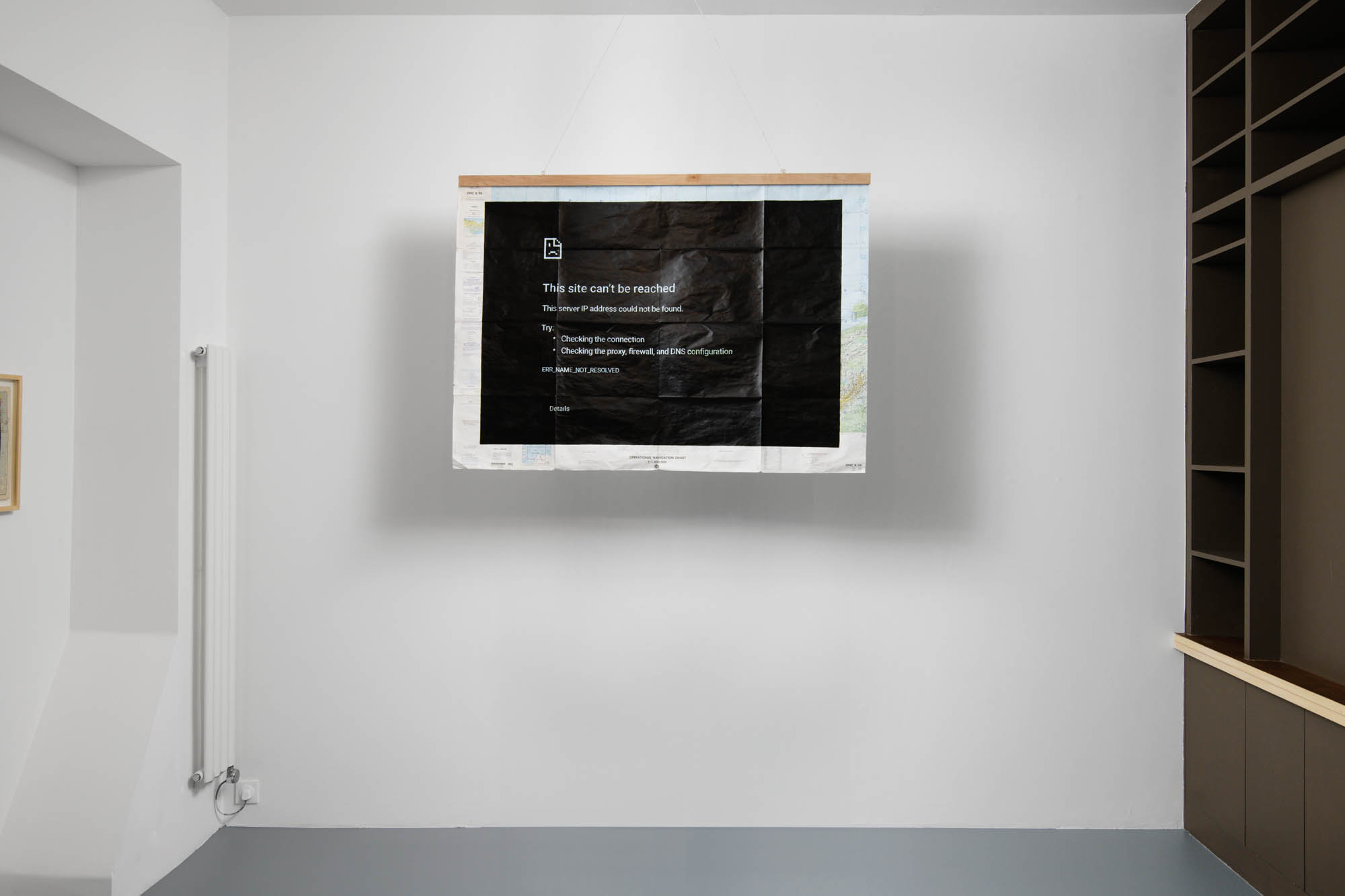
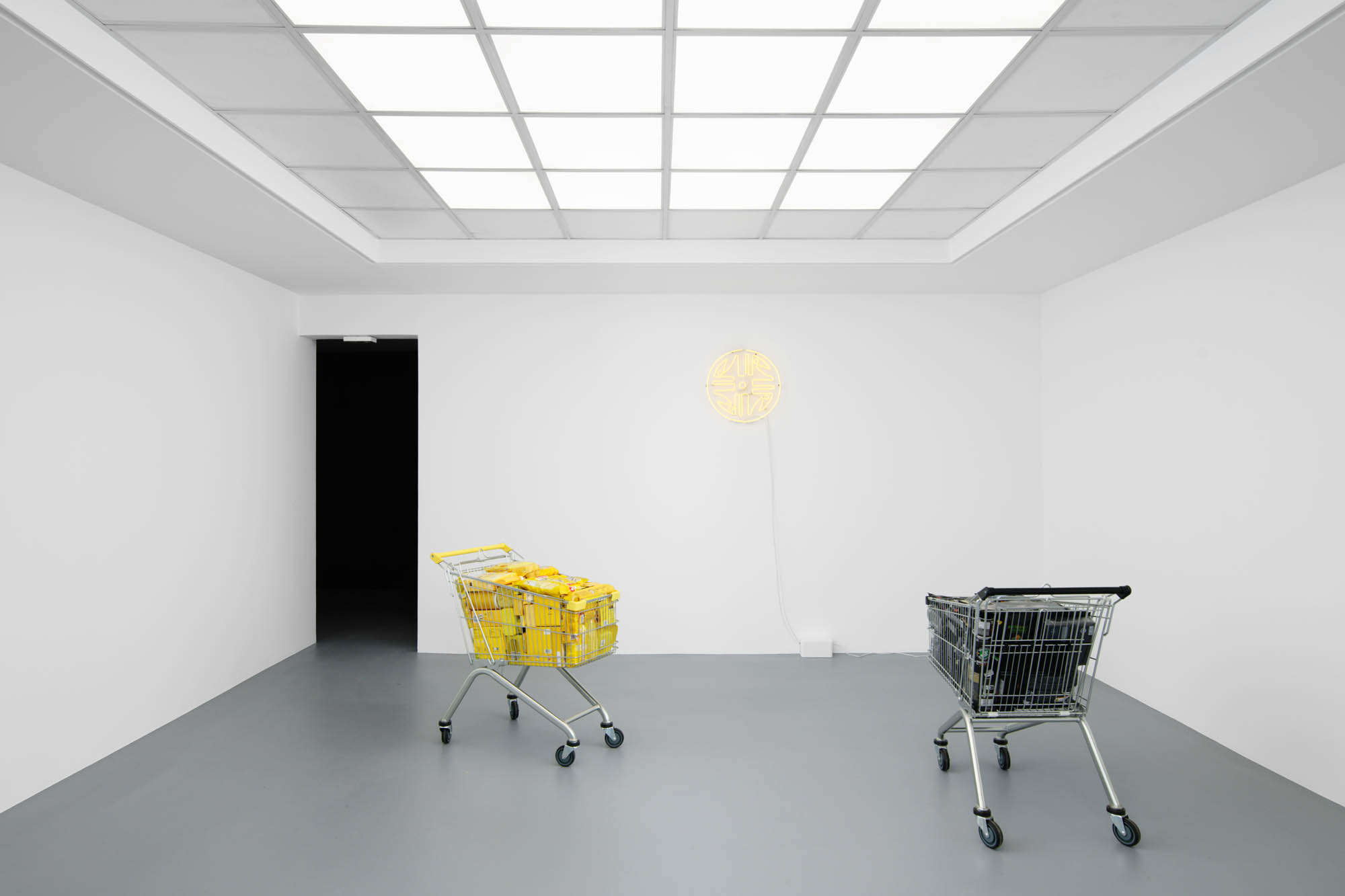
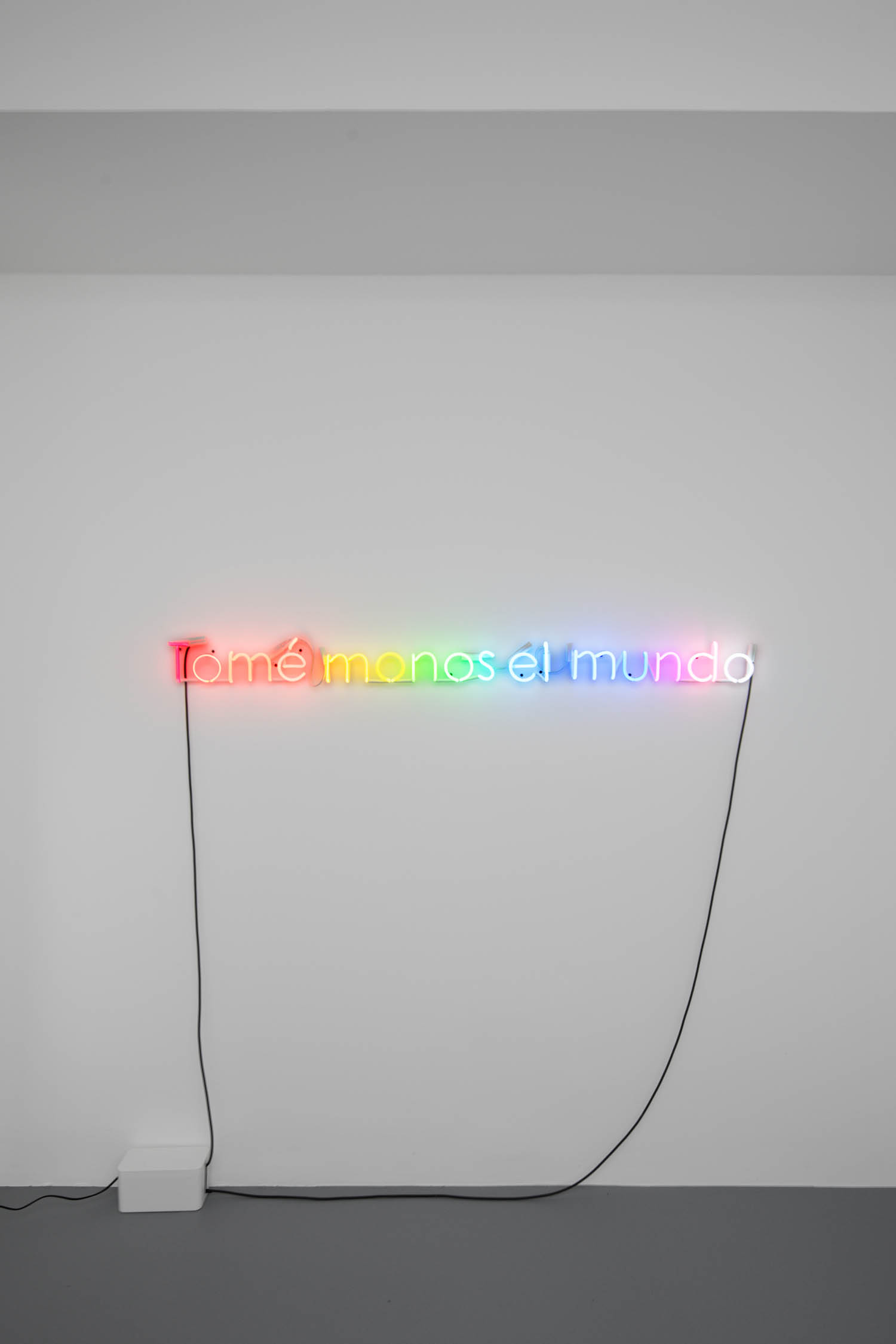


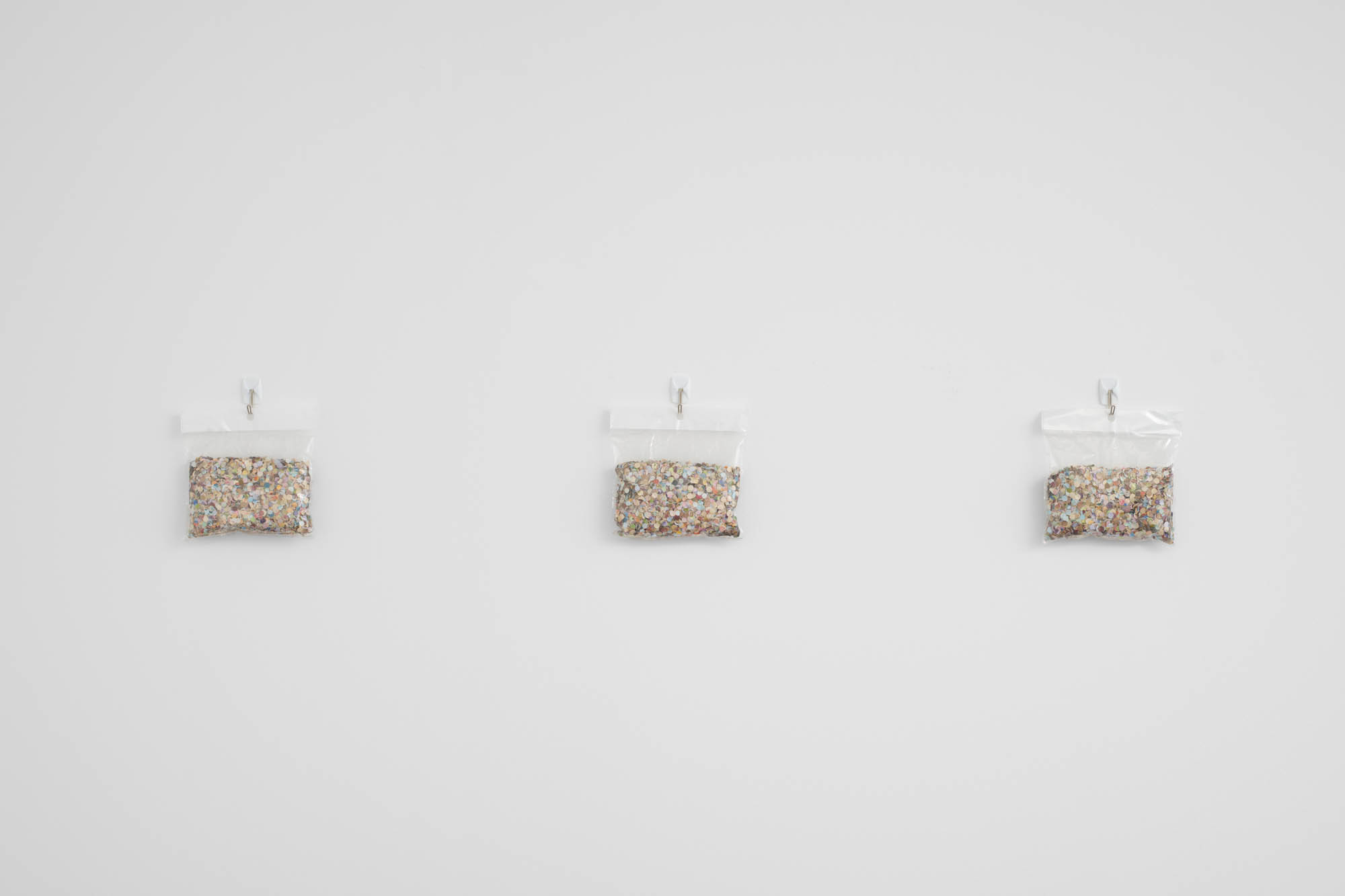
Hoffmann + Maler + Wallenberg and Micki Meng, Paris, are pleased to announce their first exhibition at the latter’s new location, Adriana Martínez Barón’s Taking Over the World. Martínez Barón (b. 1988, Bogotá) is emblematic of a new wave of Latin American artists who are making poetic, elegant, and politically astute contributions to the global art scene. Hailing from Colombia and of Indigenous heritage, Martínez Barón pursued her artistic education at the Universidad de los Andes in Bogotá, and presently splits her time between San Juan, Puerto Rico, and Bogotá.
Despite her deep roots in Latin America, Martínez Barón’s artistic vision transcends geographical boundaries, grappling with the complex repercussions of globalization. The artist navigates the subtle yet profound impacts of the international art market on local cultures, opting for nuanced and gently subversive gestures over the overt ideological critiques often associated with previous generations of politically engaged South American artists.
In a world dominated by globalized economies, where skills and commodities interchange freely, the artist incorporates everyday objects, drawing from the imagery-saturated landscape of mass-market culture to comment on the global dissemination of such images. Through her art, Martínez Barón manipulates layers, collapses symbols, and inverts familiar objects to construct vivid imagery imbued with cultural references.
At the heart of Martínez Barón’s visual explorations lies a probing examination of Latin America’s—particularly Colombia’s—unequal role in global economic exchange. Beneath the surface of her playful creations lies a poignant invitation to consider not just the monetary costs of international trade but the human toll exacted by a global economic system that enriches some while impoverishing others. The art straddles a delicate balance between commodity and value, often employing money—in its physical form and as a concept—as a central motif. Martínez Barón challenges conventional notions of value by incorporating into her works actual currency to point to its fluctuating rates and movement across borders and economies.
Drawing inspiration from Karl Marx’s observations in Capital (1867), Martínez Barón’s art underscores the intrinsic link between value and labor. It highlights how currency, when removed from its economic frameworks and circulation networks, loses its value, only to regain it when transformed into artworks and introduced into the art market. The 1980s marked a period of economic reckoning for many Latin American nations as they grappled with the consequences of mounting foreign debt and hyperinflation. Martínez Barón’s artistic predecessors, like Brazilian artist Jac Leirner, responded to this tumultuous era by utilizing devalued currency to symbolize the unraveling of modernity through financial crises.
Beyond hyperinflation, Martínez Barón’s repurposing of devalued currency gestures to money laundering, organized crime, and the illicit defacement of banknotes—the darker aspects of global finance. Her examinations of produce stickers, for instance, reveal the hidden costs of commodification, namely the exploitation and expropriation underlying multinational corporations’ activities in regions like Central America and Colombia. The work serves as a powerful reminder of the ongoing struggles faced by Latin American nations, highlighting the complex interplay between local economies and global markets. By engaging with these issues, Martínez Barón offers a nuanced commentary on globalization and free trade, inviting viewers to contemplate the intricate connections between value, labor, and financial instability in her home region. In essence, the work serves as a poignant reflection on the economic and social upheavals that have shaped Latin America, and offers a compelling narrative of resilience and creativity amid adversity.
Martínez Barón has exhibited widely across Latin America, the United States, and Europe, with solo and group exhibitions at such prestigious venues as the Museum of Contemporary Art Detroit; Embajada, San Juan, Puerto Rico; Hoffmann + Maler + Wallenberg, Nice, France; the Museo de Arte Moderno de Bogotá; Rachel Uffner Gallery, New York; Cristina Guerra, Lisbon; Steve Turner, Los Angeles; DiabloRosso, Panama City; the Jewish Museum, New York; Instituto de Vision, Bogotá; Jessica Silverman, San Francisco; and Chicago Manual Style, Chicago.
Hoffmann + Maler + Wallenberg and Micki Meng, Paris, are pleased to announce their first exhibition at the latter’s new location, Adriana Martínez Barón’s Taking Over the World. Martínez Barón (b. 1988, Bogotá) is emblematic of a new wave of Latin American artists who are making poetic, elegant, and politically astute contributions to the global art scene. Hailing from Colombia and of Indigenous heritage, Martínez Barón pursued her artistic education at the Universidad de los Andes in Bogotá, and presently splits her time between San Juan, Puerto Rico, and Bogotá.
Despite her deep roots in Latin America, Martínez Barón’s artistic vision transcends geographical boundaries, grappling with the complex repercussions of globalization. The artist navigates the subtle yet profound impacts of the international art market on local cultures, opting for nuanced and gently subversive gestures over the overt ideological critiques often associated with previous generations of politically engaged South American artists.
In a world dominated by globalized economies, where skills and commodities interchange freely, the artist incorporates everyday objects, drawing from the imagery-saturated landscape of mass-market culture to comment on the global dissemination of such images. Through her art, Martínez Barón manipulates layers, collapses symbols, and inverts familiar objects to construct vivid imagery imbued with cultural references.
At the heart of Martínez Barón’s visual explorations lies a probing examination of Latin America’s—particularly Colombia’s—unequal role in global economic exchange. Beneath the surface of her playful creations lies a poignant invitation to consider not just the monetary costs of international trade but the human toll exacted by a global economic system that enriches some while impoverishing others. The art straddles a delicate balance between commodity and value, often employing money—in its physical form and as a concept—as a central motif. Martínez Barón challenges conventional notions of value by incorporating into her works actual currency to point to its fluctuating rates and movement across borders and economies.
Drawing inspiration from Karl Marx’s observations in Capital (1867), Martínez Barón’s art underscores the intrinsic link between value and labor. It highlights how currency, when removed from its economic frameworks and circulation networks, loses its value, only to regain it when transformed into artworks and introduced into the art market. The 1980s marked a period of economic reckoning for many Latin American nations as they grappled with the consequences of mounting foreign debt and hyperinflation. Martínez Barón’s artistic predecessors, like Brazilian artist Jac Leirner, responded to this tumultuous era by utilizing devalued currency to symbolize the unraveling of modernity through financial crises.
Beyond hyperinflation, Martínez Barón’s repurposing of devalued currency gestures to money laundering, organized crime, and the illicit defacement of banknotes—the darker aspects of global finance. Her examinations of produce stickers, for instance, reveal the hidden costs of commodification, namely the exploitation and expropriation underlying multinational corporations’ activities in regions like Central America and Colombia. The work serves as a powerful reminder of the ongoing struggles faced by Latin American nations, highlighting the complex interplay between local economies and global markets. By engaging with these issues, Martínez Barón offers a nuanced commentary on globalization and free trade, inviting viewers to contemplate the intricate connections between value, labor, and financial instability in her home region. In essence, the work serves as a poignant reflection on the economic and social upheavals that have shaped Latin America, and offers a compelling narrative of resilience and creativity amid adversity.
Martínez Barón has exhibited widely across Latin America, the United States, and Europe, with solo and group exhibitions at such prestigious venues as the Museum of Contemporary Art Detroit; Embajada, San Juan, Puerto Rico; Hoffmann + Maler + Wallenberg, Nice, France; the Museo de Arte Moderno de Bogotá; Rachel Uffner Gallery, New York; Cristina Guerra, Lisbon; Steve Turner, Los Angeles; DiabloRosso, Panama City; the Jewish Museum, New York; Instituto de Vision, Bogotá; Jessica Silverman, San Francisco; and Chicago Manual Style, Chicago.
Hoffmann + Maler + Wallenberg and Micki Meng, Paris, are pleased to announce their first exhibition at the latter’s new location, Adriana Martínez Barón’s Taking Over the World. Martínez Barón (b. 1988, Bogotá) is emblematic of a new wave of Latin American artists who are making poetic, elegant, and politically astute contributions to the global art scene. Hailing from Colombia and of Indigenous heritage, Martínez Barón pursued her artistic education at the Universidad de los Andes in Bogotá, and presently splits her time between San Juan, Puerto Rico, and Bogotá.
Despite her deep roots in Latin America, Martínez Barón’s artistic vision transcends geographical boundaries, grappling with the complex repercussions of globalization. The artist navigates the subtle yet profound impacts of the international art market on local cultures, opting for nuanced and gently subversive gestures over the overt ideological critiques often associated with previous generations of politically engaged South American artists.
In a world dominated by globalized economies, where skills and commodities interchange freely, the artist incorporates everyday objects, drawing from the imagery-saturated landscape of mass-market culture to comment on the global dissemination of such images. Through her art, Martínez Barón manipulates layers, collapses symbols, and inverts familiar objects to construct vivid imagery imbued with cultural references.
At the heart of Martínez Barón’s visual explorations lies a probing examination of Latin America’s—particularly Colombia’s—unequal role in global economic exchange. Beneath the surface of her playful creations lies a poignant invitation to consider not just the monetary costs of international trade but the human toll exacted by a global economic system that enriches some while impoverishing others. The art straddles a delicate balance between commodity and value, often employing money—in its physical form and as a concept—as a central motif. Martínez Barón challenges conventional notions of value by incorporating into her works actual currency to point to its fluctuating rates and movement across borders and economies.
Drawing inspiration from Karl Marx’s observations in Capital (1867), Martínez Barón’s art underscores the intrinsic link between value and labor. It highlights how currency, when removed from its economic frameworks and circulation networks, loses its value, only to regain it when transformed into artworks and introduced into the art market. The 1980s marked a period of economic reckoning for many Latin American nations as they grappled with the consequences of mounting foreign debt and hyperinflation. Martínez Barón’s artistic predecessors, like Brazilian artist Jac Leirner, responded to this tumultuous era by utilizing devalued currency to symbolize the unraveling of modernity through financial crises.
Beyond hyperinflation, Martínez Barón’s repurposing of devalued currency gestures to money laundering, organized crime, and the illicit defacement of banknotes—the darker aspects of global finance. Her examinations of produce stickers, for instance, reveal the hidden costs of commodification, namely the exploitation and expropriation underlying multinational corporations’ activities in regions like Central America and Colombia. The work serves as a powerful reminder of the ongoing struggles faced by Latin American nations, highlighting the complex interplay between local economies and global markets. By engaging with these issues, Martínez Barón offers a nuanced commentary on globalization and free trade, inviting viewers to contemplate the intricate connections between value, labor, and financial instability in her home region. In essence, the work serves as a poignant reflection on the economic and social upheavals that have shaped Latin America, and offers a compelling narrative of resilience and creativity amid adversity.
Martínez Barón has exhibited widely across Latin America, the United States, and Europe, with solo and group exhibitions at such prestigious venues as the Museum of Contemporary Art Detroit; Embajada, San Juan, Puerto Rico; Hoffmann + Maler + Wallenberg, Nice, France; the Museo de Arte Moderno de Bogotá; Rachel Uffner Gallery, New York; Cristina Guerra, Lisbon; Steve Turner, Los Angeles; DiabloRosso, Panama City; the Jewish Museum, New York; Instituto de Vision, Bogotá; Jessica Silverman, San Francisco; and Chicago Manual Style, Chicago.
Hoffmann + Maler + Wallenberg and Micki Meng, Paris, are pleased to announce their first exhibition at the latter’s new location, Adriana Martínez Barón’s Taking Over the World. Martínez Barón (b. 1988, Bogotá) is emblematic of a new wave of Latin American artists who are making poetic, elegant, and politically astute contributions to the global art scene. Hailing from Colombia and of Indigenous heritage, Martínez Barón pursued her artistic education at the Universidad de los Andes in Bogotá, and presently splits her time between San Juan, Puerto Rico, and Bogotá.
Despite her deep roots in Latin America, Martínez Barón’s artistic vision transcends geographical boundaries, grappling with the complex repercussions of globalization. The artist navigates the subtle yet profound impacts of the international art market on local cultures, opting for nuanced and gently subversive gestures over the overt ideological critiques often associated with previous generations of politically engaged South American artists.
In a world dominated by globalized economies, where skills and commodities interchange freely, the artist incorporates everyday objects, drawing from the imagery-saturated landscape of mass-market culture to comment on the global dissemination of such images. Through her art, Martínez Barón manipulates layers, collapses symbols, and inverts familiar objects to construct vivid imagery imbued with cultural references.
At the heart of Martínez Barón’s visual explorations lies a probing examination of Latin America’s—particularly Colombia’s—unequal role in global economic exchange. Beneath the surface of her playful creations lies a poignant invitation to consider not just the monetary costs of international trade but the human toll exacted by a global economic system that enriches some while impoverishing others. The art straddles a delicate balance between commodity and value, often employing money—in its physical form and as a concept—as a central motif. Martínez Barón challenges conventional notions of value by incorporating into her works actual currency to point to its fluctuating rates and movement across borders and economies.
Drawing inspiration from Karl Marx’s observations in Capital (1867), Martínez Barón’s art underscores the intrinsic link between value and labor. It highlights how currency, when removed from its economic frameworks and circulation networks, loses its value, only to regain it when transformed into artworks and introduced into the art market. The 1980s marked a period of economic reckoning for many Latin American nations as they grappled with the consequences of mounting foreign debt and hyperinflation. Martínez Barón’s artistic predecessors, like Brazilian artist Jac Leirner, responded to this tumultuous era by utilizing devalued currency to symbolize the unraveling of modernity through financial crises.
Beyond hyperinflation, Martínez Barón’s repurposing of devalued currency gestures to money laundering, organized crime, and the illicit defacement of banknotes—the darker aspects of global finance. Her examinations of produce stickers, for instance, reveal the hidden costs of commodification, namely the exploitation and expropriation underlying multinational corporations’ activities in regions like Central America and Colombia. The work serves as a powerful reminder of the ongoing struggles faced by Latin American nations, highlighting the complex interplay between local economies and global markets. By engaging with these issues, Martínez Barón offers a nuanced commentary on globalization and free trade, inviting viewers to contemplate the intricate connections between value, labor, and financial instability in her home region. In essence, the work serves as a poignant reflection on the economic and social upheavals that have shaped Latin America, and offers a compelling narrative of resilience and creativity amid adversity.
Martínez Barón has exhibited widely across Latin America, the United States, and Europe, with solo and group exhibitions at such prestigious venues as the Museum of Contemporary Art Detroit; Embajada, San Juan, Puerto Rico; Hoffmann + Maler + Wallenberg, Nice, France; the Museo de Arte Moderno de Bogotá; Rachel Uffner Gallery, New York; Cristina Guerra, Lisbon; Steve Turner, Los Angeles; DiabloRosso, Panama City; the Jewish Museum, New York; Instituto de Vision, Bogotá; Jessica Silverman, San Francisco; and Chicago Manual Style, Chicago.











Adriana Martínez Barón
CMYK
2017–ongoing
Four metal shopping carts, spray paint, spray primer, glossy varnish, groceries and household supplies from local supermarkets
104 × 64 × 81 cm each

Adriana Martínez Barón
CMYK
2017–ongoing
Four metal shopping carts, spray paint, spray primer, glossy varnish, groceries and household supplies from local supermarkets
104 × 64 × 81 cm each

Adriana Martínez Barón
CMYK
2017–ongoing
Four metal shopping carts, spray paint, spray primer, glossy varnish, groceries and household supplies from local supermarkets
104 × 64 × 81 cm each

Adriana Martínez Barón
CMYK
2017–ongoing
Four metal shopping carts, spray paint, spray primer, glossy varnish, groceries and household supplies from local supermarkets
104 × 64 × 81 cm each

Adriana Martínez Barón
CMYK
2017–ongoing
Four metal shopping carts, spray paint, spray primer, glossy varnish, groceries and household supplies from local supermarkets
104 × 64 × 81 cm each

Adriana Martínez Barón
CMYK
2017–ongoing
Four metal shopping carts, spray paint, spray primer, glossy varnish, groceries and household supplies from local supermarkets
104 × 64 × 81 cm each

Adriana Martínez Barón
CMYK
2017–ongoing
Four metal shopping carts, spray paint, spray primer, glossy varnish, groceries and household supplies from local supermarkets
104 × 64 × 81 cm each

Adriana Martínez Barón
CMYK
2017–ongoing
Four metal shopping carts, spray paint, spray primer, glossy varnish, groceries and household supplies from local supermarkets
104 × 64 × 81 cm each

Adriana Martínez Barón
Peyote Fan
2023
Banknotes, wood, leather, beads, horsehair
47 × 27 cm

Adriana Martínez Barón
Prophecy
2023
Banknotes
114.3 × 58.4 × 63.5 cm

Adriana Martínez Barón
Doscientos pesos oro
2024
Neon
57 × 57 cm

Adriana Martínez Barón
40-48 (Lemon Tree)
2023
Stickers on faux plant
56 × 50 × 50 cm

Adriana Martínez Barón
40-48 (Lemon Tree)
2023
Stickers on faux plant
56 × 50 × 50 cm

Adriana Martínez Barón
At the End of the Rainbow
2023
Banknotes and rubber band
7 × 7 × 7 cm

Adriana Martínez Barón
At the End of the Rainbow
2023
Banknotes and rubber band
7 × 7 × 7 cm

Adriana Martínez Barón
Denegada (Denied)
2023
Acrylic paint, vintage map
59 × 25 cm (unframed)
64 × 30 cm (framed)

Adriana Martínez Barón
Tomémonos El Mundo
2024
Neon
11× 167 cm

Adriana Martínez Barón
Time Flies (detail)
2023
Acrylic paint, vintage maps
Asia, Europe, and America
36 × 50 cm (unframed)
44 × 58 cm (framed)
Oceania and Africa
26 × 37 cm (unframed)
33 × 44 cm (framed)

Adriana Martínez Barón
Time Flies (detail)
2023
Acrylic paint, vintage maps
Asia, Europe, and America
36 × 50 cm (unframed)
44 × 58 cm (framed)
Oceania and Africa
26 × 37 cm (unframed)
33 × 44 cm (framed)

Adriana Martínez Barón
Time Flies (detail)
2023
Acrylic paint, vintage maps
Asia, Europe, and America
36 × 50 cm (unframed)
44 × 58 cm (framed)
Oceania and Africa
26 × 37 cm (unframed)
33 × 44 cm (framed)

Adriana Martínez Barón
Time Flies (detail)
2023
Acrylic paint, vintage maps
Asia, Europe, and America
36 × 50 cm (unframed)
44 × 58 cm (framed)
Oceania and Africa
26 × 37 cm (unframed)
33 × 44 cm (framed)

Adriana Martínez Barón
Time Flies (detail)
2023
Acrylic paint, vintage maps
Asia, Europe, and America
36 × 50 cm (unframed)
44 × 58 cm (framed)
Oceania and Africa
26 × 37 cm (unframed)
33 × 44 cm (framed)

Adriana Martínez Barón
This Site Can’t Be Reached
2023
Acrylic paint on vintage map
145 × 104 cm